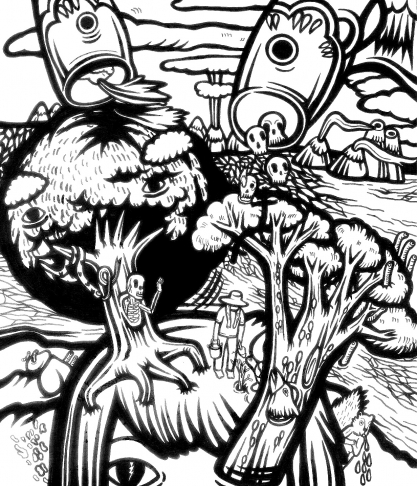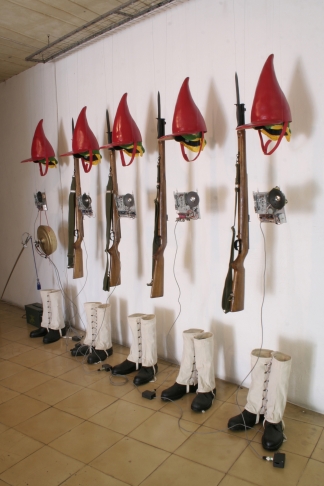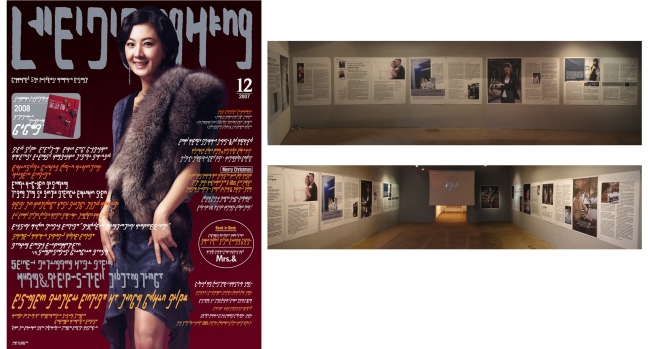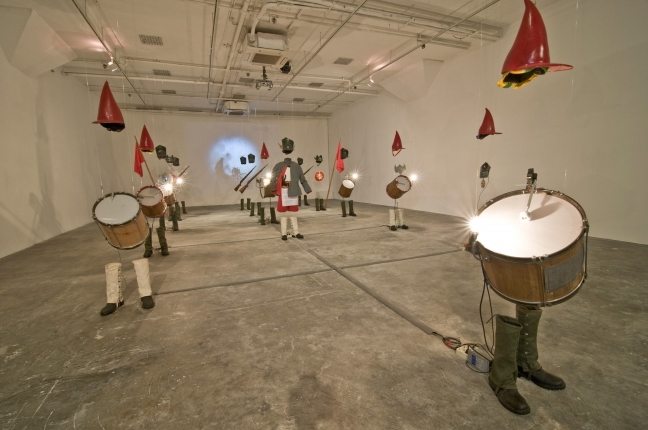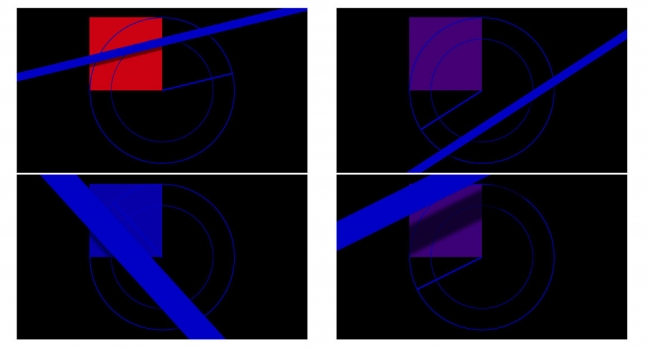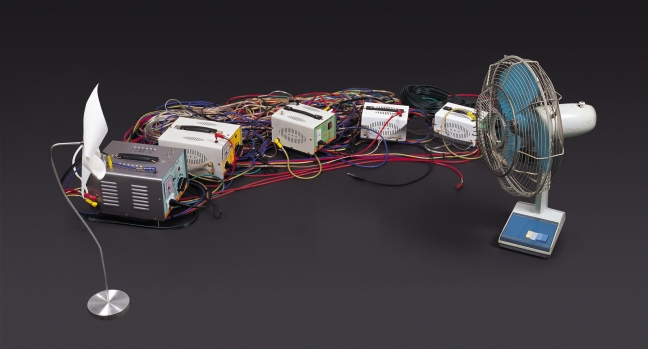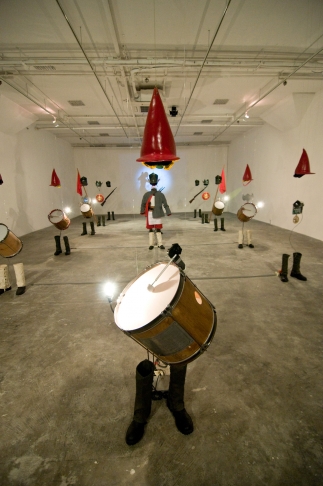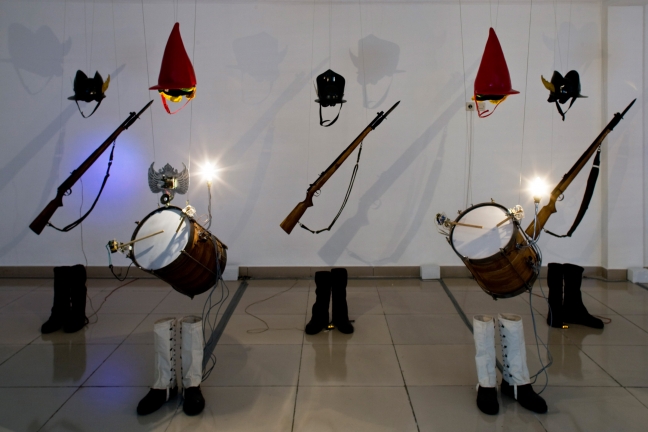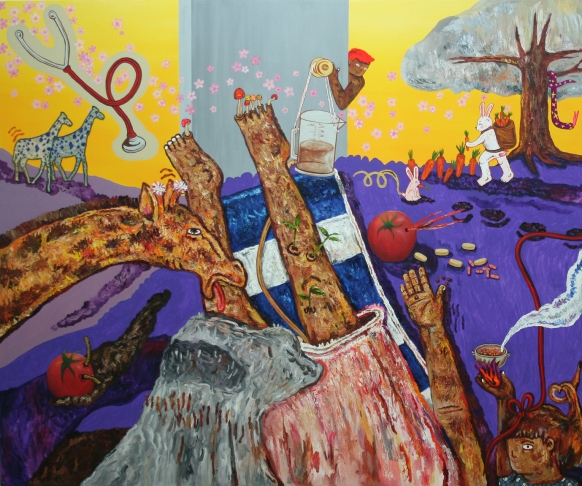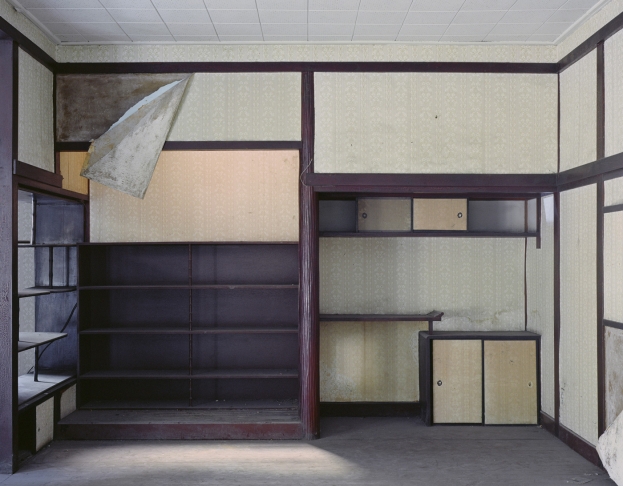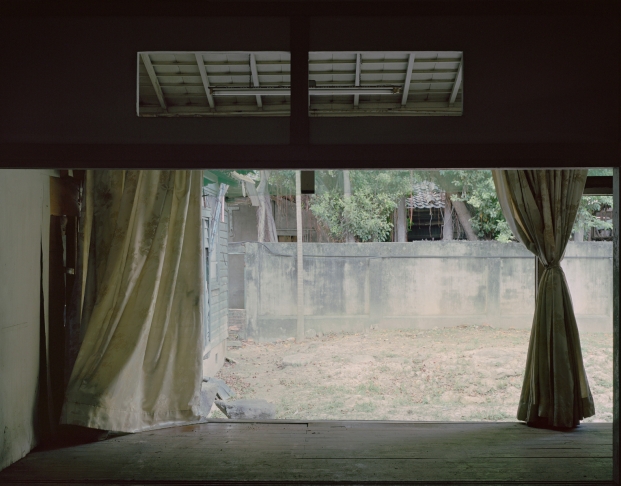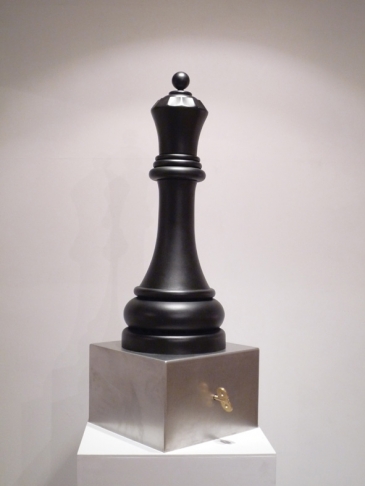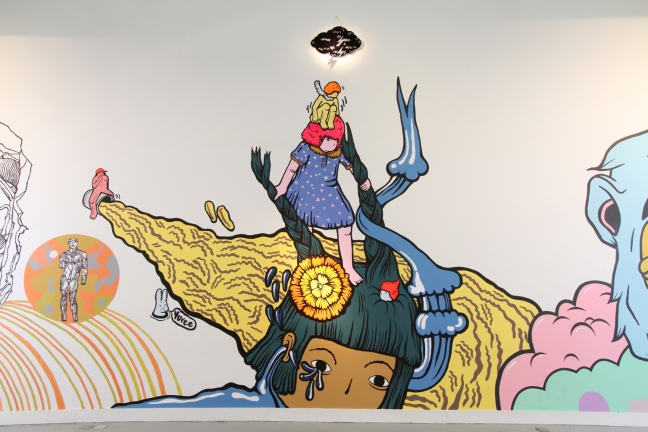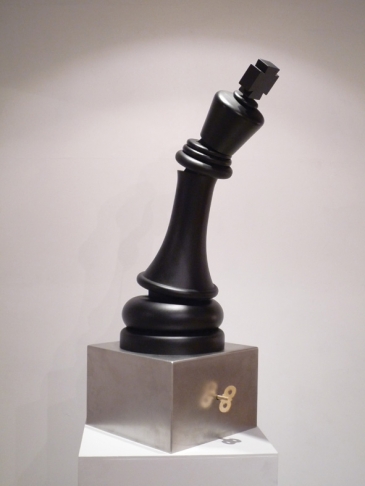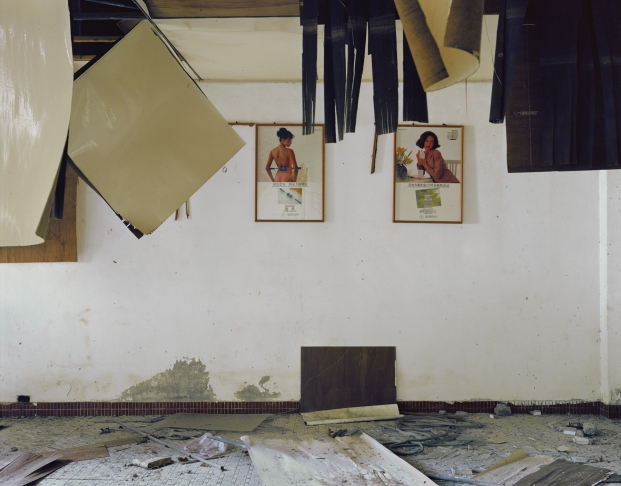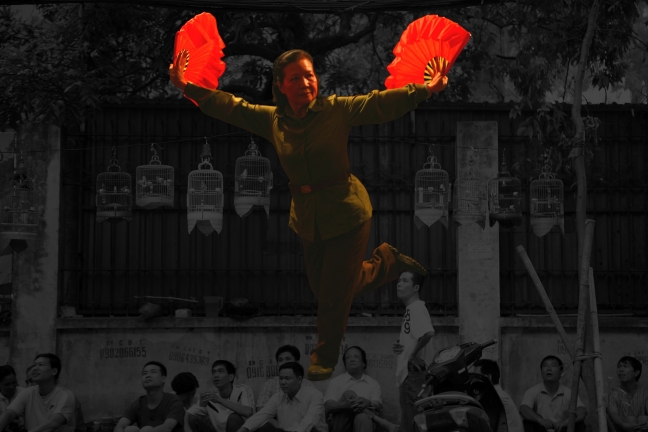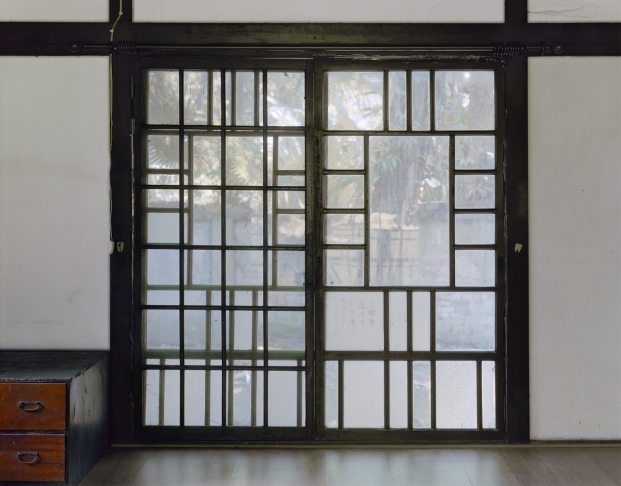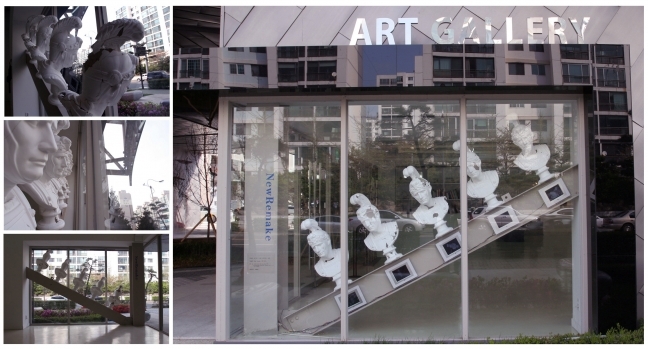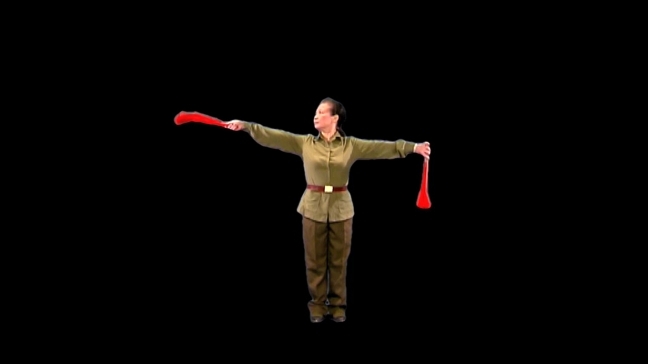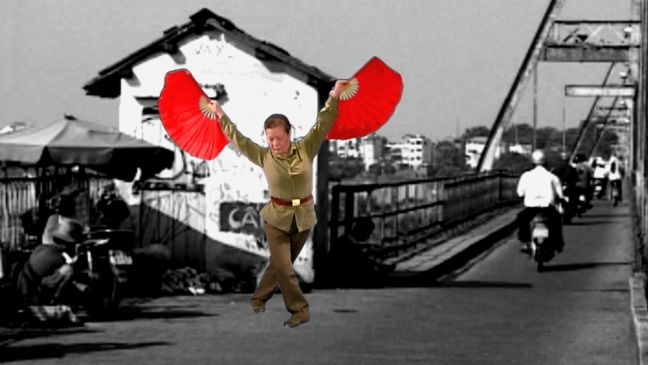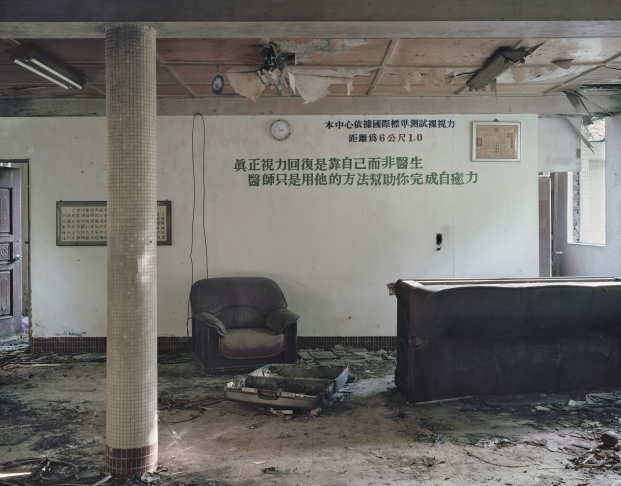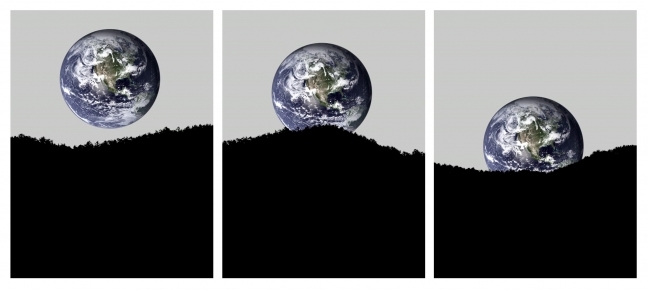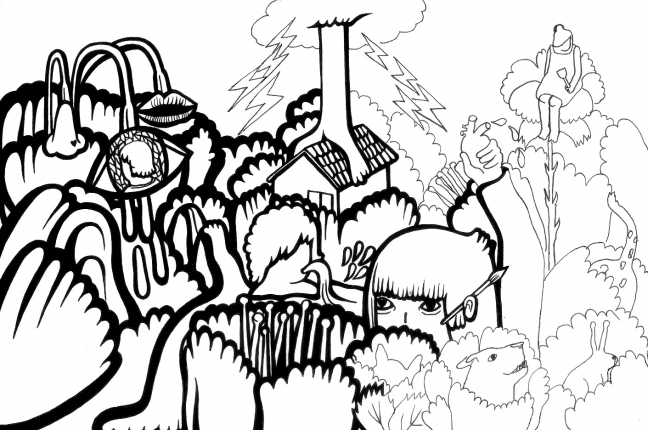Memories and Beyond / 2010 Kuandu Biennale
2010.10.08~2010.12.26
09:00 - 17:00
Kuandu Biennale 2010 PLUS/ Memories and Beyond The Kuandu Museum of Fine Arts is proud to present its second Biennale: PLUS/ Memoriesand Beyond. Based on the concept of ‘memories and beyond,’ 10 Asian artists from different regions in Asia have been invited to choose their own curators and to work with the museum’s team to explore the idea of what Asian art means today through their artworks, discussions amongst themselves and the establishment of an on-going interactive network. Memory is an inner world of past and present images, involving psychological and mental reflection of events. It often inspires artists in many ways. The Biennale’s concept is meant to suggest the idea of memories and all those with remote connection as a window into the subconscious, an imaginary realm, a fantasy, a lost world, or even a surreal state. The Biennale will also address the differences between various regions and races of Asia, as well as examine the influence of the West on Asian culture. With these works of art, the exhibition wishes to present Asian characters of memories, historical experience and body politics. Everyone has memories. Artists interpret their memories with forms which we can all share, and through which new social possibilities are provoked and suggested. Based on the idea of artists’ memories, Kuandu Biennale 2010 will use the artists’ works as a springboard to explore issues of globalization in Asian society from the viewpoint of artists, as well as of curators and museum directors, working in different regions of Asia.
Kuandu Biennale 2010 PLUS/ Memories and Beyond The Kuandu Museum of Fine Arts is proud to present its second Biennale: PLUS/ Memoriesand Beyond. Based on the concept of ‘memories and beyond,’ 10 Asian artists from different regions in Asia have been invited to choose their own curators and to work with the museum’s team to explore the idea of what Asian art means today through their artworks, discussions amongst themselves and the establishment of an on-going interactive network. Memory is an inner world of past and present images, involving psychological and mental reflection of events. It often inspires artists in many ways. The Biennale’s concept is meant to suggest the idea of memories and all those with remote connection as a window into the subconscious, an imaginary realm, a fantasy, a lost world, or even a surreal state. The Biennale will also address the differences between various regions and races of Asia, as well as examine the influence of the West on Asian culture. With these works of art, the exhibition wishes to present Asian characters of memories, historical experience and body politics. Everyone has memories. Artists interpret their memories with forms which we can all share, and through which new social possibilities are provoked and suggested. Based on the idea of artists’ memories, Kuandu Biennale 2010 will use the artists’ works as a springboard to explore issues of globalization in Asian society from the viewpoint of artists, as well as of curators and museum directors, working in different regions of Asia.
Of Infinite Possibilities and The Garden of Forking Paths An interview with Vertical Submarine (Fiona Koh, Justin Loke and Joshua Yang) by Eugene Tan ET: I would like to ask how you arrived at Vertical Submarine for the name of your collective? VS: This came about through a conversation with a fellow Singaporean artist, who was the recipient of the Jacques Derrida Prize. He told us how during the prize-giving ceremony, Derrida, who spoke very little English, kept repeating the word ‘subvert’ while congratulating him. Since then, we became fascinated with the word ‘subvert’ and the context of the conversation between Derrida and this artist. We then decided to subvert the word ‘subvert’, to end up with the phrase ‘vert sub’. From there, the name ‘Vertical Submarine’ suggested itself to us. ET: In many ways, the name Vertical Submarine, and the way in which it came into being, goes a long way in explaining your practice and concerns as an artistic collective. Many of your works deal with the notion of subverting received knowledge and popular perception, and their relationship to memory. I take for example one of your early works, Foreign Talents (2007), in which you erected two sculptures of migrant workers, one opposite a monument to Sir Stamford Raffles, the founder of Singapore and the other in the ‘Little India’ district in Singapore, where Indian migrant workers congregate. By juxtaposing a monument of a migrant worker with that of Raffles, the work highlights the loss of collective memory, of the numerous and faceless migrant workers who have contributed to Singapore’s development, and instead, how Singapore as a society still looks to and reveres its colonial past. The title of the work, Foreign Talent, is also a tongue-in-cheek reference to the foreign (often Caucasian) expatriates who live and work in Singapore, who are seen by the government and corporations to be crucial to Singapore’s development, unlike the migrant workers. It is this ironic sense of humour which I also find interesting and which recurs in your work. In your most recent work, The Garden of Forking Path, your work has taken a new development, not longer just questioning received knowledge and perception but show new possibilities for the construction of meaning. VS: The Garden of Forking Paths comes out of our interest in the relationship between text and the image, such as in Decomposition I and Decomposition II. De-composition, or decomposing, the opposite of composition, is derived from our interest in post-structuralist deconstruction, to subvert the meanings of texts and the functions of books. The Garden of Forking Paths is inspired by a short story of the same title by Argentine writer Jorge Luis Borges. This multidimensional Borgesian tale is composed with complex conceptual and narrative layers, and several labyrinth models from physical, metaphysical and symbolic realms. There are two aspects in the story which relate specifically to our project. First, the reader, as the reader of the ‘historical document’ – written by the character Dr. Yu Tsun, a former English Professor – is situated within a war espionage scenario. The setting and characters in the story are like allegorical figures, or codes waiting to be deciphered. For instance, at the end of the story Dr. Yu Tsun, who is also a German agent, had to murder the Sinologist Stephen Albert he arranged a meeting with in order to communicate to Berlin the name of the city the Germans should raid. Second, the setting in China relates the reader to a labyrinthine garden constructed by Tsun’s grandfather Ts’ui Pen, a Qing dynasty writer and official who undertook the project of writing a novel for 13 years, but left only incomplete and chaotic manuscripts with endless possibilities for the plot and narrative. Like the symbolic and physical labyrinths mentioned in the story, the story as a whole with the various twists and turns are mutual reflections of infinite relations. ET: Beyond it façade as a World War 2 spy story, Borges’s short story and his concept of the forking paths, has been seen as the inspiration for new media theory and hypertext fiction, especially where he writes of ‘a labyrinth that folds back upon itself in infinite regression.’ Your installation, The Garden of Forking Paths, as it was first shown at Grey Projects in Singapore, takes the form of a labyrinth into which viewers enter. How do you see the relationship between your labyrinth and the labyrinth constructed by Ts’ui Pen in Borges’s story? VS: This project is not an attempt at a word-for-word construction of the labyrinth mentioned in the story. The installation is actually based on our interpretation of parts the house inhabited by Stephen Albert. The viewer encounters a forking path that leads them into two different ‘ends’ of the work after entering the space. The first path leads one to the study and the garden; and second to the ‘secret’ room. The notion of materiality, of physical manifestation and experience, is extended to the concept of the labyrinth explored by Borges. Primarily, this collective project is of dual aspects. Our main concern lies with how the experience of the physical labyrinth could be analogous to the experience of reading and writing. The ‘concrete’ walls in the installation is to be read as a ‘literal’ and ‘concrete’ manifestation of the idea, where concretisation could mean both physical presence and realisation or the simply the state of a matter. As a metaphor, the ‘lines’ of fold is the lines of text. In this literary labyrinth, the walls create passages that would lead the viewers – depending on their choices – towards reading different interpretations and conclusion(s) of the project. Upon entering the exhibition space, the viewer will encounter the ‘excerpt’ from Borges’s The Garden of Forking Paths that elaborates the concept of labyrinth and the notion of infinite possibility. For viewers who are familiar with the short story would recognise how this excerpt has actually been subtly doctored to expand the concept of a labyrinthine structure. In our reading of Borges’s text, we noticed how he did not elaborate notions of return, repetition, reverse and double, when he recounts the various possible outcomes of Tsui Pen’s novel. Thus, we edited words and inserted sentences into the passage (see text-image below) to reiterate these concepts which are often the essence of most Borgesian tale, and to emphasise how the horror of one being trapped in a labyrinth includes the vicious cycle of endless repetition and return. […]Naturally, there are several possible outcomes: Fang can kill the intruder, the intruder can kill Fang, they can switch roles, they both can escape, they both can die, and so forth. In the work of Ts'ui Pên, all possible outcomes occur; each one is the point of departure for other forkings and repetitions. Sometimes, the paths of this labyrinth converge: for example, you arrive at this house, but in one of the possible pasts you are my enemy, in another, my friend. The scenario could also double itself as in a mirror. If you will resign yourself to my incurable pronunciation, we shall read a few pages."
His face, within the vivid circle of the lamplight, was unquestionably that of an old man, but with something unalterable about it, even immortal. He read with slow precision three versions of the same epic chapter. In the first, an army marches to a battle across a lonely mountain; the horror of the rocks and shadows makes the men undervalue their lives and they gain an easy victory. In the second, the same army traverses a palace where a great festival is taking place; the resplendent battle seems to them a continuation of the celebration and they win the victory. In the third, the same army strategically raided and completely razed a village the enemy troops laid ambush; the heroic victory necessitates the cruelty of undervaluing the lives of the peasant folks. I listened with proper veneration to these ancient narratives, perhaps less admirable in themselves than the fact that they had been created by my blood and were being restored to me by a man of a remote empire, in the course of a desperate adventure, on a Western isle. I remember the last words, repeated in each version like a secret commandment: Thus fought the heroes, tranquil their admirable hearts, violent their swords, resigned to kill and to die. The Garden of Forking Paths – Jorge Luis Borges (pp.26-27) The working copy of the doctored excerpt, The Garden of Forking Paths, 2010, vertical submarine ET: In the installation, several objects which you have previously used, appear again, such as wardrobes and mirrors. The mirror, in particular, is especially significant in your work as a subversive tool, to subvert meaning. This was also evident in Foreign Talent, where the monument of the migrant worker mirrored and thereby challenged the position of the existing monument of Raffles. The notion of mirroring is, of course, an important notion in post-structuralist theory, particularly in Jacques Lacan’s ‘mirror stage’ of human development, where the child and the development of its Ego happens through its experience with the ‘mirror image’, where it assumes an identity through seeing itself being seen. VS: The objects in the installation are based on the character Tsui Pen, the writer cum builder of the labyrinth garden. Along the wall adjacent to where the wall text is located, the viewer will also noticed forty-nine book-sized wooden tableaus containing plans of mazes and labyrinths from various eras and regions. As the viewer proceeds towards the far end of the wall, he/she will be forced to choose between two paths. If the viewer were to continue the journey by choosing the path on the right, he/she would be led to a chamber with a pyramid glass cabinet displaying a labyrinth model. To get close enough to scrutinise the model, the viewer would have to walk over a ‘dead body’ (as part of the installation, an actor was engaged to play dead). It would be apparent that the labyrinth model is based on the labyrinth the viewer is located – however this model is actually a misrepresentation of the space. The viewer who took the left path would enter a room. In this room, the items include a table with a drawer containing the actual model of the labyrinth, a painting, a vase, a half-played weiqi (or Othello) chess set, a ‘mirror’ and an inverted wall text. The ‘mirror’ is located on the wall opposite the inverted wall text. The viewer will notice how the ‘mirror’ is actually the entrance to the ‘inner chamber’ where everything in this room is reflected, doubled and inverted. For instance, the text, which is another version of the doctored excerpt, is readable; the chess set is in a reversed scenario; the drawer in table contains the inverted version of the labyrinth. If the viewer were to venture further by exiting through the other end of the ‘inner chamber’ , which is the ‘mirror reflection’ of the ‘entrance’ of the previous room, he/she would encounter a secret of garden of artificial flowers. Contrary to common sensibility, the sentence ‘Nature is a whore’ (with reference to Kurt Cobain’s song lyrics In Bloom) will be inscribed on the wall. Following this path of artificial flowers, the viewer will be eventually led to a toilet where he/she could decide, whether to answer to the ‘call of nature’ there. This project is based on the awareness of our position as a silent reader, and a sort of ‘translator’, caught between the lines of the text and our world. Existing on the margin of a page, our situation as artist-translator is the situation of one trapped in the passage of a labyrinthine reality. The task in this context is a form of visual translation where words from one language are not necessarily substituted with words from another. Instead it is substitution for a form of visual language where words as the readymade materials are replaced with, perceived as or transformed into images.
His face, within the vivid circle of the lamplight, was unquestionably that of an old man, but with something unalterable about it, even immortal. He read with slow precision three versions of the same epic chapter. In the first, an army marches to a battle across a lonely mountain; the horror of the rocks and shadows makes the men undervalue their lives and they gain an easy victory. In the second, the same army traverses a palace where a great festival is taking place; the resplendent battle seems to them a continuation of the celebration and they win the victory. In the third, the same army strategically raided and completely razed a village the enemy troops laid ambush; the heroic victory necessitates the cruelty of undervaluing the lives of the peasant folks. I listened with proper veneration to these ancient narratives, perhaps less admirable in themselves than the fact that they had been created by my blood and were being restored to me by a man of a remote empire, in the course of a desperate adventure, on a Western isle. I remember the last words, repeated in each version like a secret commandment: Thus fought the heroes, tranquil their admirable hearts, violent their swords, resigned to kill and to die. The Garden of Forking Paths – Jorge Luis Borges (pp.26-27) The working copy of the doctored excerpt, The Garden of Forking Paths, 2010, vertical submarine ET: In the installation, several objects which you have previously used, appear again, such as wardrobes and mirrors. The mirror, in particular, is especially significant in your work as a subversive tool, to subvert meaning. This was also evident in Foreign Talent, where the monument of the migrant worker mirrored and thereby challenged the position of the existing monument of Raffles. The notion of mirroring is, of course, an important notion in post-structuralist theory, particularly in Jacques Lacan’s ‘mirror stage’ of human development, where the child and the development of its Ego happens through its experience with the ‘mirror image’, where it assumes an identity through seeing itself being seen. VS: The objects in the installation are based on the character Tsui Pen, the writer cum builder of the labyrinth garden. Along the wall adjacent to where the wall text is located, the viewer will also noticed forty-nine book-sized wooden tableaus containing plans of mazes and labyrinths from various eras and regions. As the viewer proceeds towards the far end of the wall, he/she will be forced to choose between two paths. If the viewer were to continue the journey by choosing the path on the right, he/she would be led to a chamber with a pyramid glass cabinet displaying a labyrinth model. To get close enough to scrutinise the model, the viewer would have to walk over a ‘dead body’ (as part of the installation, an actor was engaged to play dead). It would be apparent that the labyrinth model is based on the labyrinth the viewer is located – however this model is actually a misrepresentation of the space. The viewer who took the left path would enter a room. In this room, the items include a table with a drawer containing the actual model of the labyrinth, a painting, a vase, a half-played weiqi (or Othello) chess set, a ‘mirror’ and an inverted wall text. The ‘mirror’ is located on the wall opposite the inverted wall text. The viewer will notice how the ‘mirror’ is actually the entrance to the ‘inner chamber’ where everything in this room is reflected, doubled and inverted. For instance, the text, which is another version of the doctored excerpt, is readable; the chess set is in a reversed scenario; the drawer in table contains the inverted version of the labyrinth. If the viewer were to venture further by exiting through the other end of the ‘inner chamber’ , which is the ‘mirror reflection’ of the ‘entrance’ of the previous room, he/she would encounter a secret of garden of artificial flowers. Contrary to common sensibility, the sentence ‘Nature is a whore’ (with reference to Kurt Cobain’s song lyrics In Bloom) will be inscribed on the wall. Following this path of artificial flowers, the viewer will be eventually led to a toilet where he/she could decide, whether to answer to the ‘call of nature’ there. This project is based on the awareness of our position as a silent reader, and a sort of ‘translator’, caught between the lines of the text and our world. Existing on the margin of a page, our situation as artist-translator is the situation of one trapped in the passage of a labyrinthine reality. The task in this context is a form of visual translation where words from one language are not necessarily substituted with words from another. Instead it is substitution for a form of visual language where words as the readymade materials are replaced with, perceived as or transformed into images.
Of Infinite Possibilities and The Garden of Forking Paths An interview with Vertical Submarine (Fiona Koh, Justin Loke and Joshua Yang) by Eugene Tan ET: I would like to ask how you arrived at Vertical Submarine for the name of your collective? VS: This came about through a conversation with a fellow Singaporean artist, who was the recipient of the Jacques Derrida Prize. He told us how during the prize-giving ceremony, Derrida, who spoke very little English, kept repeating the word ‘subvert’ while congratulating him. Since then, we became fascinated with the word ‘subvert’ and the context of the conversation between Derrida and this artist. We then decided to subvert the word ‘subvert’, to end up with the phrase ‘vert sub’. From there, the name ‘Vertical Submarine’ suggested itself to us. ET: In many ways, the name Vertical Submarine, and the way in which it came into being, goes a long way in explaining your practice and concerns as an artistic collective. Many of your works deal with the notion of subverting received knowledge and popular perception, and their relationship to memory. I take for example one of your early works, Foreign Talents (2007), in which you erected two sculptures of migrant workers, one opposite a monument to Sir Stamford Raffles, the founder of Singapore and the other in the ‘Little India’ district in Singapore, where Indian migrant workers congregate. By juxtaposing a monument of a migrant worker with that of Raffles, the work highlights the loss of collective memory, of the numerous and faceless migrant workers who have contributed to Singapore’s development, and instead, how Singapore as a society still looks to and reveres its colonial past. The title of the work, Foreign Talent, is also a tongue-in-cheek reference to the foreign (often Caucasian) expatriates who live and work in Singapore, who are seen by the government and corporations to be crucial to Singapore’s development, unlike the migrant workers. It is this ironic sense of humour which I also find interesting and which recurs in your work. In your most recent work, The Garden of Forking Path, your work has taken a new development, not longer just questioning received knowledge and perception but show new possibilities for the construction of meaning. VS: The Garden of Forking Paths comes out of our interest in the relationship between text and the image, such as in Decomposition I and Decomposition II. De-composition, or decomposing, the opposite of composition, is derived from our interest in post-structuralist deconstruction, to subvert the meanings of texts and the functions of books. The Garden of Forking Paths is inspired by a short story of the same title by Argentine writer Jorge Luis Borges. This multidimensional Borgesian tale is composed with complex conceptual and narrative layers, and several labyrinth models from physical, metaphysical and symbolic realms. There are two aspects in the story which relate specifically to our project. First, the reader, as the reader of the ‘historical document’ – written by the character Dr. Yu Tsun, a former English Professor – is situated within a war espionage scenario. The setting and characters in the story are like allegorical figures, or codes waiting to be deciphered. For instance, at the end of the story Dr. Yu Tsun, who is also a German agent, had to murder the Sinologist Stephen Albert he arranged a meeting with in order to communicate to Berlin the name of the city the Germans should raid. Second, the setting in China relates the reader to a labyrinthine garden constructed by Tsun’s grandfather Ts’ui Pen, a Qing dynasty writer and official who undertook the project of writing a novel for 13 years, but left only incomplete and chaotic manuscripts with endless possibilities for the plot and narrative. Like the symbolic and physical labyrinths mentioned in the story, the story as a whole with the various twists and turns are mutual reflections of infinite relations. ET: Beyond it façade as a World War 2 spy story, Borges’s short story and his concept of the forking paths, has been seen as the inspiration for new media theory and hypertext fiction, especially where he writes of ‘a labyrinth that folds back upon itself in infinite regression.’ Your installation, The Garden of Forking Paths, as it was first shown at Grey Projects in Singapore, takes the form of a labyrinth into which viewers enter. How do you see the relationship between your labyrinth and the labyrinth constructed by Ts’ui Pen in Borges’s story? VS: This project is not an attempt at a word-for-word construction of the labyrinth mentioned in the story. The installation is actually based on our interpretation of parts the house inhabited by Stephen Albert. The viewer encounters a forking path that leads them into two different ‘ends’ of the work after entering the space. The first path leads one to the study and the garden; and second to the ‘secret’ room. The notion of materiality, of physical manifestation and experience, is extended to the concept of the labyrinth explored by Borges. Primarily, this collective project is of dual aspects. Our main concern lies with how the experience of the physical labyrinth could be analogous to the experience of reading and writing. The ‘concrete’ walls in the installation is to be read as a ‘literal’ and ‘concrete’ manifestation of the idea, where concretisation could mean both physical presence and realisation or the simply the state of a matter. As a metaphor, the ‘lines’ of fold is the lines of text. In this literary labyrinth, the walls create passages that would lead the viewers – depending on their choices – towards reading different interpretations and conclusion(s) of the project. Upon entering the exhibition space, the viewer will encounter the ‘excerpt’ from Borges’s The Garden of Forking Paths that elaborates the concept of labyrinth and the notion of infinite possibility. For viewers who are familiar with the short story would recognise how this excerpt has actually been subtly doctored to expand the concept of a labyrinthine structure. In our reading of Borges’s text, we noticed how he did not elaborate notions of return, repetition, reverse and double, when he recounts the various possible outcomes of Tsui Pen’s novel. Thus, we edited words and inserted sentences into the passage (see text-image below) to reiterate these concepts which are often the essence of most Borgesian tale, and to emphasise how the horror of one being trapped in a labyrinth includes the vicious cycle of endless repetition and return. […]Naturally, there are several possible outcomes: Fang can kill the intruder, the intruder can kill Fang, they can switch roles, they both can escape, they both can die, and so forth. In the work of Ts'ui Pên, all possible outcomes occur; each one is the point of departure for other forkings and repetitions. Sometimes, the paths of this labyrinth converge: for example, you arrive at this house, but in one of the possible pasts you are my enemy, in another, my friend. The scenario could also double itself as in a mirror. If you will resign yourself to my incurable pronunciation, we shall read a few pages."
His face, within the vivid circle of the lamplight, was unquestionably that of an old man, but with something unalterable about it, even immortal. He read with slow precision three versions of the same epic chapter. In the first, an army marches to a battle across a lonely mountain; the horror of the rocks and shadows makes the men undervalue their lives and they gain an easy victory. In the second, the same army traverses a palace where a great festival is taking place; the resplendent battle seems to them a continuation of the celebration and they win the victory. In the third, the same army strategically raided and completely razed a village the enemy troops laid ambush; the heroic victory necessitates the cruelty of undervaluing the lives of the peasant folks. I listened with proper veneration to these ancient narratives, perhaps less admirable in themselves than the fact that they had been created by my blood and were being restored to me by a man of a remote empire, in the course of a desperate adventure, on a Western isle. I remember the last words, repeated in each version like a secret commandment: Thus fought the heroes, tranquil their admirable hearts, violent their swords, resigned to kill and to die. The Garden of Forking Paths – Jorge Luis Borges (pp.26-27) The working copy of the doctored excerpt, The Garden of Forking Paths, 2010, vertical submarine ET: In the installation, several objects which you have previously used, appear again, such as wardrobes and mirrors. The mirror, in particular, is especially significant in your work as a subversive tool, to subvert meaning. This was also evident in Foreign Talent, where the monument of the migrant worker mirrored and thereby challenged the position of the existing monument of Raffles. The notion of mirroring is, of course, an important notion in post-structuralist theory, particularly in Jacques Lacan’s ‘mirror stage’ of human development, where the child and the development of its Ego happens through its experience with the ‘mirror image’, where it assumes an identity through seeing itself being seen. VS: The objects in the installation are based on the character Tsui Pen, the writer cum builder of the labyrinth garden. Along the wall adjacent to where the wall text is located, the viewer will also noticed forty-nine book-sized wooden tableaus containing plans of mazes and labyrinths from various eras and regions. As the viewer proceeds towards the far end of the wall, he/she will be forced to choose between two paths. If the viewer were to continue the journey by choosing the path on the right, he/she would be led to a chamber with a pyramid glass cabinet displaying a labyrinth model. To get close enough to scrutinise the model, the viewer would have to walk over a ‘dead body’ (as part of the installation, an actor was engaged to play dead). It would be apparent that the labyrinth model is based on the labyrinth the viewer is located – however this model is actually a misrepresentation of the space. The viewer who took the left path would enter a room. In this room, the items include a table with a drawer containing the actual model of the labyrinth, a painting, a vase, a half-played weiqi (or Othello) chess set, a ‘mirror’ and an inverted wall text. The ‘mirror’ is located on the wall opposite the inverted wall text. The viewer will notice how the ‘mirror’ is actually the entrance to the ‘inner chamber’ where everything in this room is reflected, doubled and inverted. For instance, the text, which is another version of the doctored excerpt, is readable; the chess set is in a reversed scenario; the drawer in table contains the inverted version of the labyrinth. If the viewer were to venture further by exiting through the other end of the ‘inner chamber’ , which is the ‘mirror reflection’ of the ‘entrance’ of the previous room, he/she would encounter a secret of garden of artificial flowers. Contrary to common sensibility, the sentence ‘Nature is a whore’ (with reference to Kurt Cobain’s song lyrics In Bloom) will be inscribed on the wall. Following this path of artificial flowers, the viewer will be eventually led to a toilet where he/she could decide, whether to answer to the ‘call of nature’ there. This project is based on the awareness of our position as a silent reader, and a sort of ‘translator’, caught between the lines of the text and our world. Existing on the margin of a page, our situation as artist-translator is the situation of one trapped in the passage of a labyrinthine reality. The task in this context is a form of visual translation where words from one language are not necessarily substituted with words from another. Instead it is substitution for a form of visual language where words as the readymade materials are replaced with, perceived as or transformed into images.
His face, within the vivid circle of the lamplight, was unquestionably that of an old man, but with something unalterable about it, even immortal. He read with slow precision three versions of the same epic chapter. In the first, an army marches to a battle across a lonely mountain; the horror of the rocks and shadows makes the men undervalue their lives and they gain an easy victory. In the second, the same army traverses a palace where a great festival is taking place; the resplendent battle seems to them a continuation of the celebration and they win the victory. In the third, the same army strategically raided and completely razed a village the enemy troops laid ambush; the heroic victory necessitates the cruelty of undervaluing the lives of the peasant folks. I listened with proper veneration to these ancient narratives, perhaps less admirable in themselves than the fact that they had been created by my blood and were being restored to me by a man of a remote empire, in the course of a desperate adventure, on a Western isle. I remember the last words, repeated in each version like a secret commandment: Thus fought the heroes, tranquil their admirable hearts, violent their swords, resigned to kill and to die. The Garden of Forking Paths – Jorge Luis Borges (pp.26-27) The working copy of the doctored excerpt, The Garden of Forking Paths, 2010, vertical submarine ET: In the installation, several objects which you have previously used, appear again, such as wardrobes and mirrors. The mirror, in particular, is especially significant in your work as a subversive tool, to subvert meaning. This was also evident in Foreign Talent, where the monument of the migrant worker mirrored and thereby challenged the position of the existing monument of Raffles. The notion of mirroring is, of course, an important notion in post-structuralist theory, particularly in Jacques Lacan’s ‘mirror stage’ of human development, where the child and the development of its Ego happens through its experience with the ‘mirror image’, where it assumes an identity through seeing itself being seen. VS: The objects in the installation are based on the character Tsui Pen, the writer cum builder of the labyrinth garden. Along the wall adjacent to where the wall text is located, the viewer will also noticed forty-nine book-sized wooden tableaus containing plans of mazes and labyrinths from various eras and regions. As the viewer proceeds towards the far end of the wall, he/she will be forced to choose between two paths. If the viewer were to continue the journey by choosing the path on the right, he/she would be led to a chamber with a pyramid glass cabinet displaying a labyrinth model. To get close enough to scrutinise the model, the viewer would have to walk over a ‘dead body’ (as part of the installation, an actor was engaged to play dead). It would be apparent that the labyrinth model is based on the labyrinth the viewer is located – however this model is actually a misrepresentation of the space. The viewer who took the left path would enter a room. In this room, the items include a table with a drawer containing the actual model of the labyrinth, a painting, a vase, a half-played weiqi (or Othello) chess set, a ‘mirror’ and an inverted wall text. The ‘mirror’ is located on the wall opposite the inverted wall text. The viewer will notice how the ‘mirror’ is actually the entrance to the ‘inner chamber’ where everything in this room is reflected, doubled and inverted. For instance, the text, which is another version of the doctored excerpt, is readable; the chess set is in a reversed scenario; the drawer in table contains the inverted version of the labyrinth. If the viewer were to venture further by exiting through the other end of the ‘inner chamber’ , which is the ‘mirror reflection’ of the ‘entrance’ of the previous room, he/she would encounter a secret of garden of artificial flowers. Contrary to common sensibility, the sentence ‘Nature is a whore’ (with reference to Kurt Cobain’s song lyrics In Bloom) will be inscribed on the wall. Following this path of artificial flowers, the viewer will be eventually led to a toilet where he/she could decide, whether to answer to the ‘call of nature’ there. This project is based on the awareness of our position as a silent reader, and a sort of ‘translator’, caught between the lines of the text and our world. Existing on the margin of a page, our situation as artist-translator is the situation of one trapped in the passage of a labyrinthine reality. The task in this context is a form of visual translation where words from one language are not necessarily substituted with words from another. Instead it is substitution for a form of visual language where words as the readymade materials are replaced with, perceived as or transformed into images.
Not On the Front Lines of the Cold War An Analysis of Jau Tsai Chiu ’s World of Fatigue: M16&AK47 By: Tzu Jie Jian Jau Tsai Chiu’s World of Fatigue: M16&AK47 is the birthplace for this suspicious curatorial article. When we wind up the springs to the mechanical statues displayed in the World of Fatigue exhibition, the metallic parts to the two dark statues become taut with tension and begin to emit a slight piercing sound. As we release the springs, the two statues, in the shape of assault rifles and measuring about three meters high, bow courteously. Audiences participating and witnessing such an absurdity often cannot help but laugh. This laughter comes from the astonishment of having our preconceptions shattered. The two assault rifles, a M16 and an AK47, represent the two opposing sides of the Cold War. This seemingly important symbolization and political commentary it may have been attempting seemed to all but vanish in the face of laughter and absurdity. In fact, playful art that induces laughter is quite abundant in the Taiwanese Contemporary Art scene in recent years. This trend may originate from a total sense of absurdity or from a heavy-hearted judging mentality. Most importantly, this type of art is very accessible to the public and usually well-received. Putting aside its intended purpose, the laughter it induces is exactly what avant-garde art has been trying to achieve for many years——Not by imposing any sort of art into social interactions, but by designing the work of art in a way that allows the audience to participate in the art piece—— In this age of overly serious art exhibitions, there’s no reason to exclude these playful pieces. Such avenues of audience participation are all too rare in the current contemporary art scene. Furthermore, the interactivity of The World of Fatigue is aimed at the manipulation of certain established political and cultural icons. The preexisting concepts behind these icons make it easy for the audience to understand and participate in a way intended by the artist. In fact, the origins of The World of Fatigue can be traced back to Seven Sages and Ba Gua in a Bamboo Field (2004). This installation art piece is comprised of outdoor chairs residing in a landscape setting. Through its simple mechanical design, the audience sits with their back against a chair in the center of the Ba Gua formation with artificial bamboo chairs and sagging, fatigued fluorescent lights behind them ——Here, the icon that is being manipulated is the “Bamboo,” with its straight form representing the upstanding characteristics of literary scholars in Chinese culture. However, in the piece, Seven Sages and the Ba Gua in a Bamboo Field, those upstanding characteristics bend under the weight of the audience as they sit on it. We can say that, in this piece, the icon is separated from its original symbolization by audience participation through manipulation. Yet, in The World of Fatigue, the most interesting thing is its breakdown of “iconoclasm,” which is not only targeted towards the icon’s set meaning, but exposes the obscured truth behind them. Laughter is what makes The World of Fatigue so accessible, awaking a certain liveliness without triggering controversial social debates. The deconstruction of the established concepts behind icons gives rise to artistic manipulation of daily life in society. Perhaps, this originates from Taiwan’s non-Christian traditions of non-sanctification, or latent influences from its eras of colonization. These factors allow society to share virtually the same preconceptions when viewing certain icons. On the other hand, icons presented in The World of Fatigue, such as Taipei 101, the Eiffel Tower, Constantin Brancusi’s Infinite Column, trophies, lighthouses, statues of Mao Tse Dong and Chiang Kai Shek have all been exploited somewhat via commercial products. This pervasiveness of icons in our daily life is as though we are all living under some sort of authoritarian regime, and that we are their loyal, obedient and consuming subjects. On the point of Conciliatory Effect, many voices of criticism are appeased by a consensus——When these seemingly indestructible structures suddenly start bending as if displaying a gesture of welcome, the result is truly an inspiring effect. The art critic, Ya Chun Tai, says that she is reminded of a well known TV commercial for an energy drink, “Are You, Tired?” Wong Shang Min’s recent article, “The Counterattack of Fatigue: On Zao Tsai Chiu’s The World of Fatigue,” provides a similar description of the exhibition. The World of Fatigue points straight to the nature of people in their daily lives. It ceaselessly exposes how people tend to create a false front of strength, how people continue to push themselves even when they are wracked with fatigue...etc. He playfully invites the audience to face the reality of their fatigue, and to let fatigue counterattack for once. Yet, this sense of carrying on...of persevering against the mounting fatigue has its inspirational benefits. Although, in a rather self deprecating way——The World of Fatigue gains confirmation through the audience’s laughter, not by glorifying the grand struggle against fatigue or the shining deeds of a highly spirited individual, but, by focusing on the common fallacies of the human spirit. The success of the exhibition in creating a sense of conciliation is how it reaches out to and consoles the audiences’ depravity and sense that “We are all lacking.” And, within the safe confines of the exhibition, we are given a break from the tiresome pursuit of “What we should have and obtain.” In the shadow of deconstructed, collapsing, and bending icons, we face and accept the realities of defeat. As a result, those continuously changing semantic symbols provide a sense of joy even to outsiders. The World of Fatigue expresses a fatalistic type of climate. The 2010 Kuandu Biannual exhibition gathers young artists from all over Asia under the theme, “The Collective Memory.” Jao Tsai Chiu ’s The World of Fatigue: M16 & Ak47 points to the two opposing sides of the Cold War and the history of colonization in Asia. The two assault rifles, tall and statuesque, bend to welcome the audiences’ commands and draw laughter. We feel close to them, but, our familiarity is not from movies where these two guns often appear. They come from the mechanical movements that we conduct on a daily basis.
Not On the Front Lines of the Cold War An Analysis of Jau Tsai Chiu ’s World of Fatigue: M16&AK47 By: Tzu Jie Jian Jau Tsai Chiu’s World of Fatigue: M16&AK47 is the birthplace for this suspicious curatorial article. When we wind up the springs to the mechanical statues displayed in the World of Fatigue exhibition, the metallic parts to the two dark statues become taut with tension and begin to emit a slight piercing sound. As we release the springs, the two statues, in the shape of assault rifles and measuring about three meters high, bow courteously. Audiences participating and witnessing such an absurdity often cannot help but laugh. This laughter comes from the astonishment of having our preconceptions shattered. The two assault rifles, a M16 and an AK47, represent the two opposing sides of the Cold War. This seemingly important symbolization and political commentary it may have been attempting seemed to all but vanish in the face of laughter and absurdity. In fact, playful art that induces laughter is quite abundant in the Taiwanese Contemporary Art scene in recent years. This trend may originate from a total sense of absurdity or from a heavy-hearted judging mentality. Most importantly, this type of art is very accessible to the public and usually well-received. Putting aside its intended purpose, the laughter it induces is exactly what avant-garde art has been trying to achieve for many years——Not by imposing any sort of art into social interactions, but by designing the work of art in a way that allows the audience to participate in the art piece—— In this age of overly serious art exhibitions, there’s no reason to exclude these playful pieces. Such avenues of audience participation are all too rare in the current contemporary art scene. Furthermore, the interactivity of The World of Fatigue is aimed at the manipulation of certain established political and cultural icons. The preexisting concepts behind these icons make it easy for the audience to understand and participate in a way intended by the artist. In fact, the origins of The World of Fatigue can be traced back to Seven Sages and Ba Gua in a Bamboo Field (2004). This installation art piece is comprised of outdoor chairs residing in a landscape setting. Through its simple mechanical design, the audience sits with their back against a chair in the center of the Ba Gua formation with artificial bamboo chairs and sagging, fatigued fluorescent lights behind them ——Here, the icon that is being manipulated is the “Bamboo,” with its straight form representing the upstanding characteristics of literary scholars in Chinese culture. However, in the piece, Seven Sages and the Ba Gua in a Bamboo Field, those upstanding characteristics bend under the weight of the audience as they sit on it. We can say that, in this piece, the icon is separated from its original symbolization by audience participation through manipulation. Yet, in The World of Fatigue, the most interesting thing is its breakdown of “iconoclasm,” which is not only targeted towards the icon’s set meaning, but exposes the obscured truth behind them. Laughter is what makes The World of Fatigue so accessible, awaking a certain liveliness without triggering controversial social debates. The deconstruction of the established concepts behind icons gives rise to artistic manipulation of daily life in society. Perhaps, this originates from Taiwan’s non-Christian traditions of non-sanctification, or latent influences from its eras of colonization. These factors allow society to share virtually the same preconceptions when viewing certain icons. On the other hand, icons presented in The World of Fatigue, such as Taipei 101, the Eiffel Tower, Constantin Brancusi’s Infinite Column, trophies, lighthouses, statues of Mao Tse Dong and Chiang Kai Shek have all been exploited somewhat via commercial products. This pervasiveness of icons in our daily life is as though we are all living under some sort of authoritarian regime, and that we are their loyal, obedient and consuming subjects. On the point of Conciliatory Effect, many voices of criticism are appeased by a consensus——When these seemingly indestructible structures suddenly start bending as if displaying a gesture of welcome, the result is truly an inspiring effect. The art critic, Ya Chun Tai, says that she is reminded of a well known TV commercial for an energy drink, “Are You, Tired?” Wong Shang Min’s recent article, “The Counterattack of Fatigue: On Zao Tsai Chiu’s The World of Fatigue,” provides a similar description of the exhibition. The World of Fatigue points straight to the nature of people in their daily lives. It ceaselessly exposes how people tend to create a false front of strength, how people continue to push themselves even when they are wracked with fatigue...etc. He playfully invites the audience to face the reality of their fatigue, and to let fatigue counterattack for once. Yet, this sense of carrying on...of persevering against the mounting fatigue has its inspirational benefits. Although, in a rather self deprecating way——The World of Fatigue gains confirmation through the audience’s laughter, not by glorifying the grand struggle against fatigue or the shining deeds of a highly spirited individual, but, by focusing on the common fallacies of the human spirit. The success of the exhibition in creating a sense of conciliation is how it reaches out to and consoles the audiences’ depravity and sense that “We are all lacking.” And, within the safe confines of the exhibition, we are given a break from the tiresome pursuit of “What we should have and obtain.” In the shadow of deconstructed, collapsing, and bending icons, we face and accept the realities of defeat. As a result, those continuously changing semantic symbols provide a sense of joy even to outsiders. The World of Fatigue expresses a fatalistic type of climate. The 2010 Kuandu Biannual exhibition gathers young artists from all over Asia under the theme, “The Collective Memory.” Jao Tsai Chiu ’s The World of Fatigue: M16 & Ak47 points to the two opposing sides of the Cold War and the history of colonization in Asia. The two assault rifles, tall and statuesque, bend to welcome the audiences’ commands and draw laughter. We feel close to them, but, our familiarity is not from movies where these two guns often appear. They come from the mechanical movements that we conduct on a daily basis.
Dong Song Article 1 (2010, 9)
Art is Life
---Dialogue Between Dong Song and Bo Fong
The characteristics of Dong Song’s artworks can be summarized as follows: Based on his personal memories and experiences, he captures the more than 30 year phenomenon of China’s rapid modernization, and combines it with his untamable imagination. This fully demonstrates his creative talent and ability to work with a diverse array of mediums, which he skillfully weaves together.
Dong Song’s works hold an intellectual quality. With his works, he overturns the obsessions of daily life and directly expresses common sense, thus departing from the constraints of reason. Therefore, as he shuttles between reality and the realm of art to create his works, we can witness the materialization and intertwining of Song’s objective perspective and spiritual illusions. Within the process of artistic transformation and through the morphing of images, fiction transcends reality and imagination to become polar opposites. His elegant yet strange imagination create a sense of anachronism, in which historic figures and events get mixed up with current ones. What is reality, what is expression, etc...? These questions are all drowned out within the world of fictitious images. From this, it is evident that his creative approach goes beyond the expression of “plausibility.” Within this newly constructed world of his, Song freely synthesizes a type of Zen-like “uncertainty” that is in a state of constant flux, which can never be grasped. Thus, he constructs the “original state” of art and life. For Song, this type of Zen-like “uncertainty” is definitely not a type of formality, rather, it is a specific attitude and stance towards art and life. With this, the meaning of reality is not to be found within corresponding realities, but projected from memories of the past.
We can sense from Dong Song’s works the wisdom, “See a mountain, it is a mountain. Visit a mountain, it isn’t a mountain. In the end, it is seeing a mountain, it is only a mountain.” Perhaps only with insight into this realm of life can one truly be so succinct and concise. To conduct oneself with sincerity and peacefulness is the only way they can be true to themselves.
Fong: In your works, the boundary between life and art isn’t obvious. How do you see the relationship between life and art?
Song: To me, life is art, and art is life. An equal sign can be written between them!
Fong: Your works seldom revolve around a single main theme that expands into a grand narrative, and also does not usually use traditional or real-life symbolism. But, it is not particularly “personalized” either. Your field of view is much broader.
Song: Actually, for me, I don’t have a set style. If I had to use “style” to define my works, I think my style is my “attitude.” On this world, people don’t live in a vacuum. They are inextricably linked to the outside. What exactly is this link? How do you face these things? What attitude do you use to face it? Therefore, I am more concerned about the attitude of life and art. I like contemporary art because of the freedom of its language. It gives you lots of freedom, and does not require you to use it in any certain way.
Fong: Diversification of styles is one of the features to your works. Can you talk more specifically about the relationship between “life” and “art.”
Song: At the earliest, I received formal art education, and contemporary art went against all that I had learned. It stressed “form,” and, when I created works, I hoped to resolve personal issues such as “family relationships” through them. To date, I think my best works include “Touching My Father,” “Water Written Diary,” and “Optimal Use.” These works changed the way I viewed the world. They not only ask you to view them, but also give you a feeling of commonality. In some shifting of the media, this feeling can be awakened. For example, after viewing “Optimal Use,” many people who are not of the artistic circle also have many feelings: Everybody feels that life is just this way, but not to the extremes expressed by my mother. Once these objects are presented and the space has been replaced, people begin to re-examine them. After the setup of the exhibition, I begin to take another look at these “objects” --- art in real life plays the role of a “medium” and “lubricant.” Therefore, I thank art again and again. Another example is the “Water Written Diary.” At the beginning, I wanted to create an artwork. But, in the process of writing, I gradually felt that it was becoming an integral part and habit to my life. Now, if I have something to say, I write it through the method of “water writing.”
Fong: At the Kuandu Art Festival, you will be exhibiting your image work, “Water Memory.” Is this an extension of “Water Written Diary”?
Song: This piece was created to fit the exhibition theme, “Accumulation of Memory.” However, it is not a journal, but symbols freely drawn onto four stone slabs using white water. These symbols include natural landscapes, everyday objects and so on, without any particular point. Some are even very abstract concept imprints. Under every stone, I install a heater. When the paint brush is dipped in white water, the image of the symbol quickly evaporates. Illogical fragmented images form a continuous moment or trace of memory. Indistinct, looming, difficult to capture. Life undergoes this type of transition.
Fong: This is also your current attitude towards life and art?
Song: When young, this was the state of mind: when doing something, I hoped that everyone would pay attention to it. Or when I used a different method to paint, I hoped that everyone would notice the difference. But now, I no longer hold such a state of mind. When the motivation and attitude undergo a fundamental change, the form derived becomes no longer important.
Fong: As you said, art plays the role of a “medium.”
Song: For example, if you hosted an exhibition and invited me to participate, it might not be an opportunity for me to exhibit my work, but an opportunity for me to create it. Let me give you an example. Lin Leng’s planned exhibition, “It’s Me,” provides me a location, and this location was something that I could not previously attain on my own. This “Imperial Ancestral Temple” space particularly fits the needs of my work. Within it, even though no one has seen it, I have materialized my creation. This is very important! For another example, your planned exhibition, “Signs of Existence,” combines personal experiences with the realities of urban and rural junctions. Both the exhibition method and the implementation of the works are very interesting. Because my “Cabbage” is a special sign for the transition period from a planned economy to a market economy, I reduce it to “Cabbage” within the exhibition. It has had a relationship with the people and environment surrounding it, as well as the experiences of the past.
Fong: You just said that, through art, you resolved a few problems you have faced. What were these problems, specifically?
Song: For example, family problems. Through the piece, “Touching My Father,” I improved my relationship between me and my father. When I went to Germany to participate in an exhibition in 1997, it was the first time I was so far away from home. It was not easy to make phone calls and I could not speak the language. I was feeling particularly lonely, and my way of thinking had changed. I was “home-sick.” In Germany, the piece I exhibited was “One Hand Beating on the Floor.” Afterwards, I thought of using that hand to caress my father --- to really touch him to express my feelings towards him. That year, I was 30 years old. I had always wanted to touch my father, but was never able to cross that “threshold.” Therefore, I thought of using projections to touch him, which was convenient. After returning to Beijing, I discussed this with my father, but, he disagreed, asking, “Why do you want to touch me?” Afterwards though, my father eventually agreed. When he did, my heart tremored. Maybe to others, this isn’t important. But, to me, it is! Because I knew it was very hard for my father to agree to such a request because it might undermine his authority ---- Being a father, how could he give up his bottom line? Even for his children. At that time, he was wearing a jacket on the outside and a flower-patterned shirt. When I started to caress him, my father was smoking a cigarette. Then, he gradually noticed and began to look at my hand. When I saw him notice my hand, I then began to caress him from head to foot. Afterwards, he took off his jacket, then his shirt, and finally, his vest, until he was bare armed. My father seldom was bare armed in front of me because he wanted to maintain his dignity and authority as a father. Through this process, we did not say a word to each other. After I finished this work, I discovered that my relationship with my father improved a lot. He began to understand everything that I was trying to do through this piece. I also began to care about my father. Our conversations also increased. Sometimes we could talk with each other until past midnight. “Touching My Father” is important to me because it made me re-examine the relationship between me and my father. When my father suddenly passed away, that was when I truly touched him with courage. However, at that time, he no longer felt anything.
Fong: This reminds me of your work, “Optimal Use,” which is closely related to the experiences of your mother. When these things are fully displayed, one realizes that the feelings they kindle surpass the intrinsic concepts of “art.” They contain a sense of changing eras. Categorization of the artwork becomes irrelevant. The work’s forms are very subtle as well, with every little detail an integral part to the piece. Through reflection on your relationship with your parents, these two pieces solidify the connection between “art” and “life.” Through these works, your social perspectives have changed. You transform “Art” into a lifestyle, thus, making it an interface between people and society, people and nature, as well as between people themselves.
Song: Chinese people value family bonds. My works express these bonds, not because of me, but, rather my Chinese heritage. At most, people live to a hundred years of age and they experience many things. Yet, there is one thing a person cannot choose: their heritage. A person must face his or her heritage. And, when we have our own children, we can then fully appreciate our parents’ affectionate care towards us.
Fong: Therefore, your works have a very down-to-earth feel about them. You don’t care about the art market’s trends. Your works are personal. Furthermore, I just thought of a question. For example, you use fictitious imaging techniques in your works, “Water Writing Diaries” and “Touching My Father.” For these pieces, your father agreed to take off his clothes because he was moved by your caring intentions? I am most interested in these kinds of works of yours that portray the character of Chinese people. Another example is your work, “Beat,” which includes many Zen related insights. It made me think of Ping Xu’s work, “Dust.”
Song: I personally appreciate and respect the Zen philosophy very much. However, I don’t think I have reached a level of self enlightenment yet. In my consciousness, art and life are equal. There are two more things that equate to one another: “something” and “nothing.” I feel that “something” and “nothing” are one thing. For example, the light beam that I flash is “nothing.” But, to me it is “something.” Why do I create videos? Some people see videos as a new media, but, I disagree. Video art consists of works that can be seen, but not touched. This expresses the relationship between “have and nothing” very well. Within the exhibition you curated, “Fry Beijing,” a light beam was projected onto steam and walls. In reality, there is nothing, yet we feel that there is something there.
Fong: Your work, “Print Water,” also embodies such qualities.
Song: When I create art, I try to focus on certain topics, such as my familiarity with “water” or my interest in mirrors and introspection. “Water” is amorphous. It takes on the shape of its container and is just a blob in the vacuum of outer space. It is only in real life that water has a defined shape. I am fascinated by “water’s” three chemical states: liquid, solid, and gas. In life, there are many mirrors: ones that you can see and ones that you cannot. For example, we are having a conversation, in which I am reflecting on myself. And, “I” represent many sides to my self. When facing different people or situations, one adjusts their personality accordingly. Thus, they wear many facades. In reality, I take on many roles, which makes my work more complicated. Today, I am a tour guide for a travel agency; tomorrow, I might appear in the guise of a “son;” the day after, I might become a person who broke the mirror. Exploring myself allows me to gain more “contact points” with life.
Fong: You are very sensitive towards the concept of “borders.” This includes your experimentation with the notions of “space” and “distance&r
Dong Song Article 1 (2010, 9)
Art is Life
---Dialogue Between Dong Song and Bo Fong
The characteristics of Dong Song’s artworks can be summarized as follows: Based on his personal memories and experiences, he captures the more than 30 year phenomenon of China’s rapid modernization, and combines it with his untamable imagination. This fully demonstrates his creative talent and ability to work with a diverse array of mediums, which he skillfully weaves together.
Dong Song’s works hold an intellectual quality. With his works, he overturns the obsessions of daily life and directly expresses common sense, thus departing from the constraints of reason. Therefore, as he shuttles between reality and the realm of art to create his works, we can witness the materialization and intertwining of Song’s objective perspective and spiritual illusions. Within the process of artistic transformation and through the morphing of images, fiction transcends reality and imagination to become polar opposites. His elegant yet strange imagination create a sense of anachronism, in which historic figures and events get mixed up with current ones. What is reality, what is expression, etc...? These questions are all drowned out within the world of fictitious images. From this, it is evident that his creative approach goes beyond the expression of “plausibility.” Within this newly constructed world of his, Song freely synthesizes a type of Zen-like “uncertainty” that is in a state of constant flux, which can never be grasped. Thus, he constructs the “original state” of art and life. For Song, this type of Zen-like “uncertainty” is definitely not a type of formality, rather, it is a specific attitude and stance towards art and life. With this, the meaning of reality is not to be found within corresponding realities, but projected from memories of the past.
We can sense from Dong Song’s works the wisdom, “See a mountain, it is a mountain. Visit a mountain, it isn’t a mountain. In the end, it is seeing a mountain, it is only a mountain.” Perhaps only with insight into this realm of life can one truly be so succinct and concise. To conduct oneself with sincerity and peacefulness is the only way they can be true to themselves.
Fong: In your works, the boundary between life and art isn’t obvious. How do you see the relationship between life and art?
Song: To me, life is art, and art is life. An equal sign can be written between them!
Fong: Your works seldom revolve around a single main theme that expands into a grand narrative, and also does not usually use traditional or real-life symbolism. But, it is not particularly “personalized” either. Your field of view is much broader.
Song: Actually, for me, I don’t have a set style. If I had to use “style” to define my works, I think my style is my “attitude.” On this world, people don’t live in a vacuum. They are inextricably linked to the outside. What exactly is this link? How do you face these things? What attitude do you use to face it? Therefore, I am more concerned about the attitude of life and art. I like contemporary art because of the freedom of its language. It gives you lots of freedom, and does not require you to use it in any certain way.
Fong: Diversification of styles is one of the features to your works. Can you talk more specifically about the relationship between “life” and “art.”
Song: At the earliest, I received formal art education, and contemporary art went against all that I had learned. It stressed “form,” and, when I created works, I hoped to resolve personal issues such as “family relationships” through them. To date, I think my best works include “Touching My Father,” “Water Written Diary,” and “Optimal Use.” These works changed the way I viewed the world. They not only ask you to view them, but also give you a feeling of commonality. In some shifting of the media, this feeling can be awakened. For example, after viewing “Optimal Use,” many people who are not of the artistic circle also have many feelings: Everybody feels that life is just this way, but not to the extremes expressed by my mother. Once these objects are presented and the space has been replaced, people begin to re-examine them. After the setup of the exhibition, I begin to take another look at these “objects” --- art in real life plays the role of a “medium” and “lubricant.” Therefore, I thank art again and again. Another example is the “Water Written Diary.” At the beginning, I wanted to create an artwork. But, in the process of writing, I gradually felt that it was becoming an integral part and habit to my life. Now, if I have something to say, I write it through the method of “water writing.”
Fong: At the Kuandu Art Festival, you will be exhibiting your image work, “Water Memory.” Is this an extension of “Water Written Diary”?
Song: This piece was created to fit the exhibition theme, “Accumulation of Memory.” However, it is not a journal, but symbols freely drawn onto four stone slabs using white water. These symbols include natural landscapes, everyday objects and so on, without any particular point. Some are even very abstract concept imprints. Under every stone, I install a heater. When the paint brush is dipped in white water, the image of the symbol quickly evaporates. Illogical fragmented images form a continuous moment or trace of memory. Indistinct, looming, difficult to capture. Life undergoes this type of transition.
Fong: This is also your current attitude towards life and art?
Song: When young, this was the state of mind: when doing something, I hoped that everyone would pay attention to it. Or when I used a different method to paint, I hoped that everyone would notice the difference. But now, I no longer hold such a state of mind. When the motivation and attitude undergo a fundamental change, the form derived becomes no longer important.
Fong: As you said, art plays the role of a “medium.”
Song: For example, if you hosted an exhibition and invited me to participate, it might not be an opportunity for me to exhibit my work, but an opportunity for me to create it. Let me give you an example. Lin Leng’s planned exhibition, “It’s Me,” provides me a location, and this location was something that I could not previously attain on my own. This “Imperial Ancestral Temple” space particularly fits the needs of my work. Within it, even though no one has seen it, I have materialized my creation. This is very important! For another example, your planned exhibition, “Signs of Existence,” combines personal experiences with the realities of urban and rural junctions. Both the exhibition method and the implementation of the works are very interesting. Because my “Cabbage” is a special sign for the transition period from a planned economy to a market economy, I reduce it to “Cabbage” within the exhibition. It has had a relationship with the people and environment surrounding it, as well as the experiences of the past.
Fong: You just said that, through art, you resolved a few problems you have faced. What were these problems, specifically?
Song: For example, family problems. Through the piece, “Touching My Father,” I improved my relationship between me and my father. When I went to Germany to participate in an exhibition in 1997, it was the first time I was so far away from home. It was not easy to make phone calls and I could not speak the language. I was feeling particularly lonely, and my way of thinking had changed. I was “home-sick.” In Germany, the piece I exhibited was “One Hand Beating on the Floor.” Afterwards, I thought of using that hand to caress my father --- to really touch him to express my feelings towards him. That year, I was 30 years old. I had always wanted to touch my father, but was never able to cross that “threshold.” Therefore, I thought of using projections to touch him, which was convenient. After returning to Beijing, I discussed this with my father, but, he disagreed, asking, “Why do you want to touch me?” Afterwards though, my father eventually agreed. When he did, my heart tremored. Maybe to others, this isn’t important. But, to me, it is! Because I knew it was very hard for my father to agree to such a request because it might undermine his authority ---- Being a father, how could he give up his bottom line? Even for his children. At that time, he was wearing a jacket on the outside and a flower-patterned shirt. When I started to caress him, my father was smoking a cigarette. Then, he gradually noticed and began to look at my hand. When I saw him notice my hand, I then began to caress him from head to foot. Afterwards, he took off his jacket, then his shirt, and finally, his vest, until he was bare armed. My father seldom was bare armed in front of me because he wanted to maintain his dignity and authority as a father. Through this process, we did not say a word to each other. After I finished this work, I discovered that my relationship with my father improved a lot. He began to understand everything that I was trying to do through this piece. I also began to care about my father. Our conversations also increased. Sometimes we could talk with each other until past midnight. “Touching My Father” is important to me because it made me re-examine the relationship between me and my father. When my father suddenly passed away, that was when I truly touched him with courage. However, at that time, he no longer felt anything.
Fong: This reminds me of your work, “Optimal Use,” which is closely related to the experiences of your mother. When these things are fully displayed, one realizes that the feelings they kindle surpass the intrinsic concepts of “art.” They contain a sense of changing eras. Categorization of the artwork becomes irrelevant. The work’s forms are very subtle as well, with every little detail an integral part to the piece. Through reflection on your relationship with your parents, these two pieces solidify the connection between “art” and “life.” Through these works, your social perspectives have changed. You transform “Art” into a lifestyle, thus, making it an interface between people and society, people and nature, as well as between people themselves.
Song: Chinese people value family bonds. My works express these bonds, not because of me, but, rather my Chinese heritage. At most, people live to a hundred years of age and they experience many things. Yet, there is one thing a person cannot choose: their heritage. A person must face his or her heritage. And, when we have our own children, we can then fully appreciate our parents’ affectionate care towards us.
Fong: Therefore, your works have a very down-to-earth feel about them. You don’t care about the art market’s trends. Your works are personal. Furthermore, I just thought of a question. For example, you use fictitious imaging techniques in your works, “Water Writing Diaries” and “Touching My Father.” For these pieces, your father agreed to take off his clothes because he was moved by your caring intentions? I am most interested in these kinds of works of yours that portray the character of Chinese people. Another example is your work, “Beat,” which includes many Zen related insights. It made me think of Ping Xu’s work, “Dust.”
Song: I personally appreciate and respect the Zen philosophy very much. However, I don’t think I have reached a level of self enlightenment yet. In my consciousness, art and life are equal. There are two more things that equate to one another: “something” and “nothing.” I feel that “something” and “nothing” are one thing. For example, the light beam that I flash is “nothing.” But, to me it is “something.” Why do I create videos? Some people see videos as a new media, but, I disagree. Video art consists of works that can be seen, but not touched. This expresses the relationship between “have and nothing” very well. Within the exhibition you curated, “Fry Beijing,” a light beam was projected onto steam and walls. In reality, there is nothing, yet we feel that there is something there.
Fong: Your work, “Print Water,” also embodies such qualities.
Song: When I create art, I try to focus on certain topics, such as my familiarity with “water” or my interest in mirrors and introspection. “Water” is amorphous. It takes on the shape of its container and is just a blob in the vacuum of outer space. It is only in real life that water has a defined shape. I am fascinated by “water’s” three chemical states: liquid, solid, and gas. In life, there are many mirrors: ones that you can see and ones that you cannot. For example, we are having a conversation, in which I am reflecting on myself. And, “I” represent many sides to my self. When facing different people or situations, one adjusts their personality accordingly. Thus, they wear many facades. In reality, I take on many roles, which makes my work more complicated. Today, I am a tour guide for a travel agency; tomorrow, I might appear in the guise of a “son;” the day after, I might become a person who broke the mirror. Exploring myself allows me to gain more “contact points” with life.
Fong: You are very sensitive towards the concept of “borders.” This includes your experimentation with the notions of “space” and “distance&r
Q&A between Tai-Sung Chen and Pei-Shih Tu Pei-shih Tu (hereinafter referred to as Tu): Since my return from London to Taiwan last year, I strongly felt a change in my own awareness: That, here in Taiwan, it is difficult for me as a creative artist to continue to care about the “others.” By the “others,” I am generally referring to disadvantaged groups who suffer the adverse effects of globalization and those who are living on subsistence levels in the third world. While these concerns are actively discussed in London, the issues that bear the brunt of most public debates in Taiwan are limited to only local and national concerns. What are your thoughts on this? Tai-Sung Chen (hereinafter referred to as Chen): Actually, it is not that Taiwan is devoid of the social conflicts that result as a byproduct of globalization and capitalism. For example, foreign laborers such as domestic helpers and factory workers, and even foreign spouses can all be referred to what you term as the “others.” This is especially true of laborers, who live and work under very strenuous conditions, bound by contract, and rarely having any time for leisure. In Taipei, for example, the only time when you can see many of them is during the weekends, where they congregate in churches along Chung-Shan N. Road for Sunday Mass, or around Taipei Main Station. Of course, you might also see them in neighborhood parks, but, they are usually there accompanying children or the elderly. Foreign laborers are prevalent throughout Taiwan in cities, towns, and farms in the countryside. This is reflected in many works, such as Hou Shu-Tzu’s “Look to the Other Side: The Song of the Asian Bride” exhibition at the Kuandu Museum of Fine Arts in 2009, and Chiu Chen-Hung’s “Around Us” exhibition in May 2010. Both artists used photography, texts, sounds and installations to portray senses of apathy, avoidance and the tendency to stereotype foreign laborers in Taiwanese society. Lan Pei-Chia in her book, “Global Cinderellas: Migrant Domestics and Newly Rich Employers in Taiwan,” vividly describes the situations of many domestic workers as individuals beyond common stereotypical notions. Despite the fact that many in Taiwan are aware of these conflicts, these conditions persist under uncompassionate social norms. Books and exhibitions do not have a lasting effect. They do, however, serve as a record, and the new awareness that they may open crosses gender, status and racial boundaries. Through these works, the “others” are given identities as individuals, much like an inscription. This new awareness and sense of human compassion and respect should not be confined within the boundaries of the arts. We should not be saying, “Sorry, everything reverts back to the harsh reality outside of the exhibition,” seek to broaden people’s understanding and allow them to think beyond their local and immediate concerns. For example, how do we, the Taiwanese people exist? Compared to the native countries of migrant workers, Taiwan lacks international recognition as a sovereign nation despite its wealthy and developed industries. How does this fact affect the relationship between Taiwanese employers and migrant employees? How can Taiwan pursue self-determination for itself while ignoring its harsh treatment of migrant workers? Is Taiwan falling into a mire of contradiction? In the 2008 Taipei Biannual exhibition, Matei Bejenaru’s work “Maersk Dubai” points out a poignant reflection: that those Romanian stowaways who perished are victims of globalized capitalism. Similarly in Taiwan, the victims of progress are the aborigines, and these conflicts should not be categorized as merely a category of Han and Aborigine relations. It is very much a part of a global concern. Hsu Su-Chen and Lu Chien-Ming “Plant–Matter NeoEden” and Hsu Chia-Wei’s “Hua-Tung Village” are exhibitions that are raising awareness to aboriginal tribal life. Tu: To elaborate on the question, I think that, for certain artists, their only concern is to make art. But, because of Taiwan’s distinctive environment and its special geopolitical attributes, Taiwanese artists must first grasp an understanding of their own identity and role. What are your thoughts on this? Chen: No art can be separated from the realities of an artists’ origins. Today, we define art as a form of communication. Depending on how one’s notion is towards their own identity, the way their message is conveyed will take shape into many different forms. Perhaps, what you are asking about is the problematic nature of art. Recognition of the value of art is a common concern for our community. Art’s value may be derived from how widely it is shared and debated. Like you stated, Taiwan resides in a very special geopolitical position. We can better our understanding and observation of Taiwan’s development by comparing and observing the histories of other marginalized states throughout the world. To illustrate Taiwan’s geopolitical position, the international community and cross-strait regions wish that Taiwan maintains the status quo: sealed hermetically like a capsule and not declaring sovereignty, but, at the same time, treading carefully to further expand its economics, political and military presence. However, nobody can ask artists to work under any preset perspective. Whether an artist will respond to that calling is their own individual decision; furthermore, subjects like these are often labeled as controversial and they might not wish to introduce such drama into their lives. For example, an artist may have strong views and passion for a particular cause, but they might not choose to reflect these in their work. Though, I want to emphasize that artist self-expression regarding private matters is equally commendable because it is a method of communicating an artist’s unique perception and analysis. It also shows the public the results of their “self-interest” and own way of life. Indeed, there is a movement in our current era that has expanded the scope of art. We have begun to utilize modern art as a format to further examine the effects of the forces of culture and identity politics on the land we live on. I feel that “self-interest” can also be a part of this movement, not necessarily opposed to it. However, even if it is in the opposition...so what?! Art is created for the public. Even if only a few individuals end up participating, it is still worthwhile. On the contrary, to lean one’s work towards social issues does not make it more accessible to the mainstream public. It may be wrongfully labeled as controversial, dissentious, or derogatory, perhaps because people in Taiwan are highly sensitive to roles they propose to play in society as they balance self-determination against economic incentives. Therefore, I am asking how a person perceives identity politics. And, in terms of artistic creation, it becomes a question about aesthetics. An artistic awareness possibly started with Huang Tu-Shui’s 1920 work, “Aboriginal Child”, and developed from an exploration of local Taiwanese culture to find a wide range of internationally applicable aesthetic and ethical politics. Tu: British director Terry Gilliam’s film, Brazil, depicts a dystopian world pervaded by bureaucracy and terrorist bombings. In the film, society’s over-reliance on machines brings the whole world to the brink of catastrophe. At the end of the film, the protagonist recedes to a catatonic state, living in a utopian world within his own mind. Personally, the need for fantasy has always been a driving force behind my creative process. What are your views on the role of fantasy as a concept in the film? Chen: When you talked about this creative idea, the first thing that came to my mind was this film. The hallucinations and fantasy near the end of the film present a powerful scene: when the protagonist Sam becomes catatonic, his eyes stare blankly at the idyllic picture behind the executioner. Going back just previous moments, Sam is arrested, terrified as he is placed onto the execution chair. Though, we do not know when exactly he sees that painting, the movie plot tells us that moments before his brain is neutralized, Sam has actually experienced in his mind/imagination a whole series of twists and turns: rescue, escape, destruction of the government structure, rescue and escape with his lover into that same picturesque location depicted in the painting. Some say that this painting is an illusion used by the authorities to anesthetize their citizens and a device to tame any measures of resistance. This type of explanation is too static because, from Sam’s point of view, he uses the object for his own purposes, seeing past the illusion and making a Deluze-style escape. The saying, “when a person dies, they have nothing,” is true, but I don’t read it that way. First of all, Sam is very intelligent, with a well-connected family background, a work ethic that is able to satisfy the society, and a promising career. However, he placed his focus on other areas to escape the declining and seemingly dead system of society; Second, before he dies, the world in which his mind had been living was unable to be eliminated or taken away from him. After viewing Sam, the executioner stated that, “he has left,” as a way of saying, “he has died.” Instead, he could also be saying, “He has left this world system.” Of course, being human, this is not possible, and director T
Q&A between Tai-Sung Chen and Pei-Shih Tu Pei-shih Tu (hereinafter referred to as Tu): Since my return from London to Taiwan last year, I strongly felt a change in my own awareness: That, here in Taiwan, it is difficult for me as a creative artist to continue to care about the “others.” By the “others,” I am generally referring to disadvantaged groups who suffer the adverse effects of globalization and those who are living on subsistence levels in the third world. While these concerns are actively discussed in London, the issues that bear the brunt of most public debates in Taiwan are limited to only local and national concerns. What are your thoughts on this? Tai-Sung Chen (hereinafter referred to as Chen): Actually, it is not that Taiwan is devoid of the social conflicts that result as a byproduct of globalization and capitalism. For example, foreign laborers such as domestic helpers and factory workers, and even foreign spouses can all be referred to what you term as the “others.” This is especially true of laborers, who live and work under very strenuous conditions, bound by contract, and rarely having any time for leisure. In Taipei, for example, the only time when you can see many of them is during the weekends, where they congregate in churches along Chung-Shan N. Road for Sunday Mass, or around Taipei Main Station. Of course, you might also see them in neighborhood parks, but, they are usually there accompanying children or the elderly. Foreign laborers are prevalent throughout Taiwan in cities, towns, and farms in the countryside. This is reflected in many works, such as Hou Shu-Tzu’s “Look to the Other Side: The Song of the Asian Bride” exhibition at the Kuandu Museum of Fine Arts in 2009, and Chiu Chen-Hung’s “Around Us” exhibition in May 2010. Both artists used photography, texts, sounds and installations to portray senses of apathy, avoidance and the tendency to stereotype foreign laborers in Taiwanese society. Lan Pei-Chia in her book, “Global Cinderellas: Migrant Domestics and Newly Rich Employers in Taiwan,” vividly describes the situations of many domestic workers as individuals beyond common stereotypical notions. Despite the fact that many in Taiwan are aware of these conflicts, these conditions persist under uncompassionate social norms. Books and exhibitions do not have a lasting effect. They do, however, serve as a record, and the new awareness that they may open crosses gender, status and racial boundaries. Through these works, the “others” are given identities as individuals, much like an inscription. This new awareness and sense of human compassion and respect should not be confined within the boundaries of the arts. We should not be saying, “Sorry, everything reverts back to the harsh reality outside of the exhibition,” seek to broaden people’s understanding and allow them to think beyond their local and immediate concerns. For example, how do we, the Taiwanese people exist? Compared to the native countries of migrant workers, Taiwan lacks international recognition as a sovereign nation despite its wealthy and developed industries. How does this fact affect the relationship between Taiwanese employers and migrant employees? How can Taiwan pursue self-determination for itself while ignoring its harsh treatment of migrant workers? Is Taiwan falling into a mire of contradiction? In the 2008 Taipei Biannual exhibition, Matei Bejenaru’s work “Maersk Dubai” points out a poignant reflection: that those Romanian stowaways who perished are victims of globalized capitalism. Similarly in Taiwan, the victims of progress are the aborigines, and these conflicts should not be categorized as merely a category of Han and Aborigine relations. It is very much a part of a global concern. Hsu Su-Chen and Lu Chien-Ming “Plant–Matter NeoEden” and Hsu Chia-Wei’s “Hua-Tung Village” are exhibitions that are raising awareness to aboriginal tribal life. Tu: To elaborate on the question, I think that, for certain artists, their only concern is to make art. But, because of Taiwan’s distinctive environment and its special geopolitical attributes, Taiwanese artists must first grasp an understanding of their own identity and role. What are your thoughts on this? Chen: No art can be separated from the realities of an artists’ origins. Today, we define art as a form of communication. Depending on how one’s notion is towards their own identity, the way their message is conveyed will take shape into many different forms. Perhaps, what you are asking about is the problematic nature of art. Recognition of the value of art is a common concern for our community. Art’s value may be derived from how widely it is shared and debated. Like you stated, Taiwan resides in a very special geopolitical position. We can better our understanding and observation of Taiwan’s development by comparing and observing the histories of other marginalized states throughout the world. To illustrate Taiwan’s geopolitical position, the international community and cross-strait regions wish that Taiwan maintains the status quo: sealed hermetically like a capsule and not declaring sovereignty, but, at the same time, treading carefully to further expand its economics, political and military presence. However, nobody can ask artists to work under any preset perspective. Whether an artist will respond to that calling is their own individual decision; furthermore, subjects like these are often labeled as controversial and they might not wish to introduce such drama into their lives. For example, an artist may have strong views and passion for a particular cause, but they might not choose to reflect these in their work. Though, I want to emphasize that artist self-expression regarding private matters is equally commendable because it is a method of communicating an artist’s unique perception and analysis. It also shows the public the results of their “self-interest” and own way of life. Indeed, there is a movement in our current era that has expanded the scope of art. We have begun to utilize modern art as a format to further examine the effects of the forces of culture and identity politics on the land we live on. I feel that “self-interest” can also be a part of this movement, not necessarily opposed to it. However, even if it is in the opposition...so what?! Art is created for the public. Even if only a few individuals end up participating, it is still worthwhile. On the contrary, to lean one’s work towards social issues does not make it more accessible to the mainstream public. It may be wrongfully labeled as controversial, dissentious, or derogatory, perhaps because people in Taiwan are highly sensitive to roles they propose to play in society as they balance self-determination against economic incentives. Therefore, I am asking how a person perceives identity politics. And, in terms of artistic creation, it becomes a question about aesthetics. An artistic awareness possibly started with Huang Tu-Shui’s 1920 work, “Aboriginal Child”, and developed from an exploration of local Taiwanese culture to find a wide range of internationally applicable aesthetic and ethical politics. Tu: British director Terry Gilliam’s film, Brazil, depicts a dystopian world pervaded by bureaucracy and terrorist bombings. In the film, society’s over-reliance on machines brings the whole world to the brink of catastrophe. At the end of the film, the protagonist recedes to a catatonic state, living in a utopian world within his own mind. Personally, the need for fantasy has always been a driving force behind my creative process. What are your views on the role of fantasy as a concept in the film? Chen: When you talked about this creative idea, the first thing that came to my mind was this film. The hallucinations and fantasy near the end of the film present a powerful scene: when the protagonist Sam becomes catatonic, his eyes stare blankly at the idyllic picture behind the executioner. Going back just previous moments, Sam is arrested, terrified as he is placed onto the execution chair. Though, we do not know when exactly he sees that painting, the movie plot tells us that moments before his brain is neutralized, Sam has actually experienced in his mind/imagination a whole series of twists and turns: rescue, escape, destruction of the government structure, rescue and escape with his lover into that same picturesque location depicted in the painting. Some say that this painting is an illusion used by the authorities to anesthetize their citizens and a device to tame any measures of resistance. This type of explanation is too static because, from Sam’s point of view, he uses the object for his own purposes, seeing past the illusion and making a Deluze-style escape. The saying, “when a person dies, they have nothing,” is true, but I don’t read it that way. First of all, Sam is very intelligent, with a well-connected family background, a work ethic that is able to satisfy the society, and a promising career. However, he placed his focus on other areas to escape the declining and seemingly dead system of society; Second, before he dies, the world in which his mind had been living was unable to be eliminated or taken away from him. After viewing Sam, the executioner stated that, “he has left,” as a way of saying, “he has died.” Instead, he could also be saying, “He has left this world system.” Of course, being human, this is not possible, and director T
Resume (attachment) Artist statement (150 words minimum) The memories seem to be vague, they are like looking through the curtain...yet they are still clear in my mind. My father has gone for long time, but his implantation still is. He loved nature, growing, raising animals, especially Crap. We used to have a lot of pets, birds, squirrels, dogs, tortures, rabbits, fishes, cats, chickens, etc. and grew several of trees and flowers. “what growing in my mind” created from my image in the past about my father. Love, connection, change and loss, are all in my memory. “ vivid garden” I picked a cloudy memory but when I thought about it, the impressed feeling returned. The Rose Mose Garden (Eleven’s o clock flowers) was what we have grown together. Wonderful and vivid color of the garden came out from the blurred memory, my house was surrounded with different flowers, where some member is still alive, and some is gone. Details of exhibited works 01 ต้นไม้, ปลาครับ, กะลอก, เต่าน้อยน้อย, ลูกท้อแท้ๆ, หนอนยึกยือ, ความตาย, วิญญาณ, ตัวฉัน ฯลฯ what growing in my mind 2010 350 x 300 cm. acrylic on canvas 02 ความทรงจำสีแจ๊ดถึงคุณนายตื่นสาย vivid garden 2010 167 x 241 cm. acrylic on canvas 5 images of recent works Title: The End of Videocassettes Technique: acrylic, oil, aluminium sheet, videocassettes, VCD, furs, stools and glass mosaic Size: dimension: variable (painting: 54 x 207 cm / glass mosaic skull: 34 x 28 cm) Year: 2009 ----- Title: The Killer From Electricity Authority Technique: acrylic, carved window, painted toy skull and plastic blind Size: 112 x 80 cm Year: 2009 ---- Title: Chlorophyllous Blood Artist: Yuree Kensaku Technique: acrylic, oil and collage on canvas Size: 150 x 180 cm Year: 2008 ---- Mural by Yuree Kensaku “FOR” Wall Painting Showcase by groups of Thai graphic designers and artists at Bangkok Art and Culture Center, Bangkok, Thailand 2010 ----- Title: Please Peace Me Technique: Acrylic on Canvas and Drawing on Paper Size: (Painting) 130 x 174 cm (drawing) 21 x 30 cm Year: 2010
Resume (attachment) Artist statement (150 words minimum) The memories seem to be vague, they are like looking through the curtain...yet they are still clear in my mind. My father has gone for long time, but his implantation still is. He loved nature, growing, raising animals, especially Crap. We used to have a lot of pets, birds, squirrels, dogs, tortures, rabbits, fishes, cats, chickens, etc. and grew several of trees and flowers. “what growing in my mind” created from my image in the past about my father. Love, connection, change and loss, are all in my memory. “ vivid garden” I picked a cloudy memory but when I thought about it, the impressed feeling returned. The Rose Mose Garden (Eleven’s o clock flowers) was what we have grown together. Wonderful and vivid color of the garden came out from the blurred memory, my house was surrounded with different flowers, where some member is still alive, and some is gone. Details of exhibited works 01 ต้นไม้, ปลาครับ, กะลอก, เต่าน้อยน้อย, ลูกท้อแท้ๆ, หนอนยึกยือ, ความตาย, วิญญาณ, ตัวฉัน ฯลฯ what growing in my mind 2010 350 x 300 cm. acrylic on canvas 02 ความทรงจำสีแจ๊ดถึงคุณนายตื่นสาย vivid garden 2010 167 x 241 cm. acrylic on canvas 5 images of recent works Title: The End of Videocassettes Technique: acrylic, oil, aluminium sheet, videocassettes, VCD, furs, stools and glass mosaic Size: dimension: variable (painting: 54 x 207 cm / glass mosaic skull: 34 x 28 cm) Year: 2009 ----- Title: The Killer From Electricity Authority Technique: acrylic, carved window, painted toy skull and plastic blind Size: 112 x 80 cm Year: 2009 ---- Title: Chlorophyllous Blood Artist: Yuree Kensaku Technique: acrylic, oil and collage on canvas Size: 150 x 180 cm Year: 2008 ---- Mural by Yuree Kensaku “FOR” Wall Painting Showcase by groups of Thai graphic designers and artists at Bangkok Art and Culture Center, Bangkok, Thailand 2010 ----- Title: Please Peace Me Technique: Acrylic on Canvas and Drawing on Paper Size: (Painting) 130 x 174 cm (drawing) 21 x 30 cm Year: 2010
Nguyen Trinh Thi
Education:
2005: Master of Pacific International Affairs, University of California, San Diego (UCSD), USA. 1999: Master’s Degree in Journalism, University of Iowa, USA. 1994: Bachelor of Arts in Russian and English, Hanoi Foreign Studies College, Hanoi, Vietnam. Solo Exhibitions: 2010: ‘Domestic Art’, Nhasan Studio, Hanoi, Vietnam Group Exhibitions: 2010: ‘Sping Comes Winter After’ in ‘No Soul For Sale 2’, Tate Modern, London ‘Love Man Love Woman’, Vesoul Asian Film Festival, France. 2009: ‘Spring Comes Winter After’ and ’93 Years, 1383 Days’ in ‘‘LIM DIM’, Stenersen Museum, Oslo, Norway ‘Spring Comes Winter After’ in “Time Ligaments”, 10 Chancery Lane Gallery, Hong Kong ‘Chronicle of a Tape Recorded Over’ in ‘The Making of the New Silk Roads’, ArtHub, Bangkok, Thailand ‘Love Man Love Woman’, Yunnan Multi Culture Visual Festival, China 2008: ‘Love Man Love Woman’, Festival Costante Cambiamento, Florence, Italy ‘93 Years, 1383 Days’ and ‘The Commons’ in “10+”, Nha San Studio, Hanoi ‘Love Man Love Woman’ in “Strategies from Within: An Exhibition of Vietnamese and Cambodian Contemporary Art Practices”, Ke Center for Contemporary Arts, Shanghai, China; ‘Kunming Stories” in “In the course of our exchange”, Yunart Contemporary Art Gallery, Kunming, China; ‘Bus Terminal’ in “Re-Imagining the City”, Hanoi Fine Art University, Hanoi 2007: ‘Love Man Love Woman’, Jean Rouch International Film Festival, France ‘Love Man Love Woman’, San Francisco International Film Festival, USA
Details of exhibited works
Title: Spring Comes Winter After
Dimension: single channel, 4:30, ratio 4:3
Material : video, NTSC, DVD
Production requirements : playing LOOP
Artist Statement:
“Spring Comes Winter After” is one of my video works that utilize the visuals of death rituals as a vehicle to connect with the past and memories. The work used the footage captured at the public funeral of Le Dat, an important poet who was banned for decades in Vietnam. Le Dat was a central figure of a late-1950s literary and intellectual movem
Education:
2005: Master of Pacific International Affairs, University of California, San Diego (UCSD), USA. 1999: Master’s Degree in Journalism, University of Iowa, USA. 1994: Bachelor of Arts in Russian and English, Hanoi Foreign Studies College, Hanoi, Vietnam. Solo Exhibitions: 2010: ‘Domestic Art’, Nhasan Studio, Hanoi, Vietnam Group Exhibitions: 2010: ‘Sping Comes Winter After’ in ‘No Soul For Sale 2’, Tate Modern, London ‘Love Man Love Woman’, Vesoul Asian Film Festival, France. 2009: ‘Spring Comes Winter After’ and ’93 Years, 1383 Days’ in ‘‘LIM DIM’, Stenersen Museum, Oslo, Norway ‘Spring Comes Winter After’ in “Time Ligaments”, 10 Chancery Lane Gallery, Hong Kong ‘Chronicle of a Tape Recorded Over’ in ‘The Making of the New Silk Roads’, ArtHub, Bangkok, Thailand ‘Love Man Love Woman’, Yunnan Multi Culture Visual Festival, China 2008: ‘Love Man Love Woman’, Festival Costante Cambiamento, Florence, Italy ‘93 Years, 1383 Days’ and ‘The Commons’ in “10+”, Nha San Studio, Hanoi ‘Love Man Love Woman’ in “Strategies from Within: An Exhibition of Vietnamese and Cambodian Contemporary Art Practices”, Ke Center for Contemporary Arts, Shanghai, China; ‘Kunming Stories” in “In the course of our exchange”, Yunart Contemporary Art Gallery, Kunming, China; ‘Bus Terminal’ in “Re-Imagining the City”, Hanoi Fine Art University, Hanoi 2007: ‘Love Man Love Woman’, Jean Rouch International Film Festival, France ‘Love Man Love Woman’, San Francisco International Film Festival, USA
Details of exhibited works
Title: Spring Comes Winter After
Dimension: single channel, 4:30, ratio 4:3
Material : video, NTSC, DVD
Production requirements : playing LOOP
Artist Statement:
“Spring Comes Winter After” is one of my video works that utilize the visuals of death rituals as a vehicle to connect with the past and memories. The work used the footage captured at the public funeral of Le Dat, an important poet who was banned for decades in Vietnam. Le Dat was a central figure of a late-1950s literary and intellectual movem
Nguyen Trinh Thi
Education:
2005: Master of Pacific International Affairs, University of California, San Diego (UCSD), USA. 1999: Master’s Degree in Journalism, University of Iowa, USA. 1994: Bachelor of Arts in Russian and English, Hanoi Foreign Studies College, Hanoi, Vietnam. Solo Exhibitions: 2010: ‘Domestic Art’, Nhasan Studio, Hanoi, Vietnam Group Exhibitions: 2010: ‘Sping Comes Winter After’ in ‘No Soul For Sale 2’, Tate Modern, London ‘Love Man Love Woman’, Vesoul Asian Film Festival, France. 2009: ‘Spring Comes Winter After’ and ’93 Years, 1383 Days’ in ‘‘LIM DIM’, Stenersen Museum, Oslo, Norway ‘Spring Comes Winter After’ in “Time Ligaments”, 10 Chancery Lane Gallery, Hong Kong ‘Chronicle of a Tape Recorded Over’ in ‘The Making of the New Silk Roads’, ArtHub, Bangkok, Thailand ‘Love Man Love Woman’, Yunnan Multi Culture Visual Festival, China 2008: ‘Love Man Love Woman’, Festival Costante Cambiamento, Florence, Italy ‘93 Years, 1383 Days’ and ‘The Commons’ in “10+”, Nha San Studio, Hanoi ‘Love Man Love Woman’ in “Strategies from Within: An Exhibition of Vietnamese and Cambodian Contemporary Art Practices”, Ke Center for Contemporary Arts, Shanghai, China; ‘Kunming Stories” in “In the course of our exchange”, Yunart Contemporary Art Gallery, Kunming, China; ‘Bus Terminal’ in “Re-Imagining the City”, Hanoi Fine Art University, Hanoi 2007: ‘Love Man Love Woman’, Jean Rouch International Film Festival, France ‘Love Man Love Woman’, San Francisco International Film Festival, USA
Details of exhibited works
Title: Spring Comes Winter After
Dimension: single channel, 4:30, ratio 4:3
Material : video, NTSC, DVD
Production requirements : playing LOOP
Artist Statement:
“Spring Comes Winter After” is one of my video works that utilize the visuals of death rituals as a vehicle to connect with the past and memories. The work used the footage captured at the public funeral of Le Dat, an important poet who was banned for decades in Vietnam. Le Dat was a central figure of a late-1950s literary and intellectual movem
Education:
2005: Master of Pacific International Affairs, University of California, San Diego (UCSD), USA. 1999: Master’s Degree in Journalism, University of Iowa, USA. 1994: Bachelor of Arts in Russian and English, Hanoi Foreign Studies College, Hanoi, Vietnam. Solo Exhibitions: 2010: ‘Domestic Art’, Nhasan Studio, Hanoi, Vietnam Group Exhibitions: 2010: ‘Sping Comes Winter After’ in ‘No Soul For Sale 2’, Tate Modern, London ‘Love Man Love Woman’, Vesoul Asian Film Festival, France. 2009: ‘Spring Comes Winter After’ and ’93 Years, 1383 Days’ in ‘‘LIM DIM’, Stenersen Museum, Oslo, Norway ‘Spring Comes Winter After’ in “Time Ligaments”, 10 Chancery Lane Gallery, Hong Kong ‘Chronicle of a Tape Recorded Over’ in ‘The Making of the New Silk Roads’, ArtHub, Bangkok, Thailand ‘Love Man Love Woman’, Yunnan Multi Culture Visual Festival, China 2008: ‘Love Man Love Woman’, Festival Costante Cambiamento, Florence, Italy ‘93 Years, 1383 Days’ and ‘The Commons’ in “10+”, Nha San Studio, Hanoi ‘Love Man Love Woman’ in “Strategies from Within: An Exhibition of Vietnamese and Cambodian Contemporary Art Practices”, Ke Center for Contemporary Arts, Shanghai, China; ‘Kunming Stories” in “In the course of our exchange”, Yunart Contemporary Art Gallery, Kunming, China; ‘Bus Terminal’ in “Re-Imagining the City”, Hanoi Fine Art University, Hanoi 2007: ‘Love Man Love Woman’, Jean Rouch International Film Festival, France ‘Love Man Love Woman’, San Francisco International Film Festival, USA
Details of exhibited works
Title: Spring Comes Winter After
Dimension: single channel, 4:30, ratio 4:3
Material : video, NTSC, DVD
Production requirements : playing LOOP
Artist Statement:
“Spring Comes Winter After” is one of my video works that utilize the visuals of death rituals as a vehicle to connect with the past and memories. The work used the footage captured at the public funeral of Le Dat, an important poet who was banned for decades in Vietnam. Le Dat was a central figure of a late-1950s literary and intellectual movem
NGUYEN MINH PHUOC Education 1997 : Hanoi Fine Art University, Hanoi, Vietnam. B.F.A. 2005 : Independent Creative Art Spaces Leadership Training in Paris, France solo exhibition 2007 : Unhappy Dragon, Ryllega gallery, Hanoi, Vietnam. 2005 : Patch wings up, Gallery Nord, Berlin, Germany Please, don’t make me up, Sox 36 gallery, Berlin, Germany 2004 : The Circle, Ryllega gallery, Hanoi, Vietnam. 2003 : Untitled, Genkan gallery, Tokyo American club, Japan. 2002 : My Inconsistency, private studio, Hanoi, Vietnam. 2000 : Go west, Nha San studio, Hanoi, Vietnam. selected group exhibition 2010 : Vietnam Art Scene in IFA institute in Berlin & Stugard, Germany. 2009 : LIMDIM in DSV and Stenersen museum, Oslo, Norway and “Unhappy Dragon“ Installation art in IFA gallery Shanghai, China.. 2008 : “No title” Performance art, RYLLEGA Berlin, Germany “ ROSE & CHIKEN “ Performance art, Nhasan, Hanoi, Vietnam 2007 : Bridge of Art, Promotion for Art gallery, Zurich, Switzerland. “ CROPED “ SLOT gallery, 38 Botany Rd, Alexandria, NSW, Australia. 2006 : Exchange Artists program with Jeyum _ Art & Culture Institute. Phnong Penh, Cambodia. Performance workshop, SOC, HCM, Vietnam. 2005 : Out of Context, Huntington Beach Art Center, California, USA 2004 : Lim dim, International performance workshop, Hanoi, Vietnam. 2003 : Williamburg Bridge – Vietnam Now, WAH Center, New York. Green, Red & Yellow, Goethe Institute, Haqnoi, Vietnam. Legend Soup, Hanoi Opera House, Hanoi, Vietnam. Room – Zoom, Nha San Studio, Hanoi, Vietnam. Limited, Performance workshop at Goethe Institute,Hanoi,Vietnam 2002 : Asian to window, Contemporary Art Center, Hanoi, Vietnam Together, Nha San Studio, Hanoi ,Vietnam. Residence at Vermont Studio Center, Vermont, USA. Residence ( collaboration with Tran Luong ) in Cevitella Ranieri Castle, Umbertide, PG, ITALY 2001 : Magic Garden, Nha San Studio, Hanoi, Vietnam. Figures, Contemporary Art Center, Hanoi, Vietnam. Transporting, Contemporary Art Center, Hanoi, Vietnam. 2000 : Vietnam National exhibition of Art, Hanoi, Vietnam. 1999 : Asian Art Award , Vietnam Fine Art Museum, Hanoi, Vietnam. 1998 : Tay Nguyen Impression, Zhang Zhou, China. 1997 : Asian Art Award, Hanoi Fine Art University, Hanoi, Vietnam. conference and other 2009: Wellcome 1000year of Hanoi community project in Hanoi Open. Vietnam 2008: Open Academy project in Hanoi and Hue city, Vietnam 2008 – 2009 : Program Director of Dong Son Today Foundation Website: http://www.dongsontoday.org/ 2006: member of Intra Asia Network 2005: Attend Public Art In(ter)vention Conference in Chaing Mai, Thailand. 2004 - 2008: Co – founder RYLLEGA, Experimental Contemporary Art Gallery. Address: 1A Trang Tien str, Hanoi, Vietnam. Http : www.Ryllega.vn 1997 - 2000 : Lecturer of National pedagogy of Music & Painting college fundS received ASEP Foundation Dongsontoday Foundation. Ford Foundation Asian Cultural Council (ACC) British Council Vietnam Vermont Studio bibliography Art in American magazine, NY ARTS magazine, NY Times, The Strait Times, ASIAN ART NEW magazine, VIETNAM express new, THE THAO & VAN HOA magazine, TIA SANG magazine, TIME OUT magazine, NHAN DAN internet new, AN NINH THU DO news paper, KHOA HOC & DOI SONG news paper, LAO DONG news paper, HERITATE magazine…
NGUYEN MINH PHUOC Education 1997 : Hanoi Fine Art University, Hanoi, Vietnam. B.F.A. 2005 : Independent Creative Art Spaces Leadership Training in Paris, France solo exhibition 2007 : Unhappy Dragon, Ryllega gallery, Hanoi, Vietnam. 2005 : Patch wings up, Gallery Nord, Berlin, Germany Please, don’t make me up, Sox 36 gallery, Berlin, Germany 2004 : The Circle, Ryllega gallery, Hanoi, Vietnam. 2003 : Untitled, Genkan gallery, Tokyo American club, Japan. 2002 : My Inconsistency, private studio, Hanoi, Vietnam. 2000 : Go west, Nha San studio, Hanoi, Vietnam. selected group exhibition 2010 : Vietnam Art Scene in IFA institute in Berlin & Stugard, Germany. 2009 : LIMDIM in DSV and Stenersen museum, Oslo, Norway and “Unhappy Dragon“ Installation art in IFA gallery Shanghai, China.. 2008 : “No title” Performance art, RYLLEGA Berlin, Germany “ ROSE & CHIKEN “ Performance art, Nhasan, Hanoi, Vietnam 2007 : Bridge of Art, Promotion for Art gallery, Zurich, Switzerland. “ CROPED “ SLOT gallery, 38 Botany Rd, Alexandria, NSW, Australia. 2006 : Exchange Artists program with Jeyum _ Art & Culture Institute. Phnong Penh, Cambodia. Performance workshop, SOC, HCM, Vietnam. 2005 : Out of Context, Huntington Beach Art Center, California, USA 2004 : Lim dim, International performance workshop, Hanoi, Vietnam. 2003 : Williamburg Bridge – Vietnam Now, WAH Center, New York. Green, Red & Yellow, Goethe Institute, Haqnoi, Vietnam. Legend Soup, Hanoi Opera House, Hanoi, Vietnam. Room – Zoom, Nha San Studio, Hanoi, Vietnam. Limited, Performance workshop at Goethe Institute,Hanoi,Vietnam 2002 : Asian to window, Contemporary Art Center, Hanoi, Vietnam Together, Nha San Studio, Hanoi ,Vietnam. Residence at Vermont Studio Center, Vermont, USA. Residence ( collaboration with Tran Luong ) in Cevitella Ranieri Castle, Umbertide, PG, ITALY 2001 : Magic Garden, Nha San Studio, Hanoi, Vietnam. Figures, Contemporary Art Center, Hanoi, Vietnam. Transporting, Contemporary Art Center, Hanoi, Vietnam. 2000 : Vietnam National exhibition of Art, Hanoi, Vietnam. 1999 : Asian Art Award , Vietnam Fine Art Museum, Hanoi, Vietnam. 1998 : Tay Nguyen Impression, Zhang Zhou, China. 1997 : Asian Art Award, Hanoi Fine Art University, Hanoi, Vietnam. conference and other 2009: Wellcome 1000year of Hanoi community project in Hanoi Open. Vietnam 2008: Open Academy project in Hanoi and Hue city, Vietnam 2008 – 2009 : Program Director of Dong Son Today Foundation Website: http://www.dongsontoday.org/ 2006: member of Intra Asia Network 2005: Attend Public Art In(ter)vention Conference in Chaing Mai, Thailand. 2004 - 2008: Co – founder RYLLEGA, Experimental Contemporary Art Gallery. Address: 1A Trang Tien str, Hanoi, Vietnam. Http : www.Ryllega.vn 1997 - 2000 : Lecturer of National pedagogy of Music & Painting college fundS received ASEP Foundation Dongsontoday Foundation. Ford Foundation Asian Cultural Council (ACC) British Council Vietnam Vermont Studio bibliography Art in American magazine, NY ARTS magazine, NY Times, The Strait Times, ASIAN ART NEW magazine, VIETNAM express new, THE THAO & VAN HOA magazine, TIA SANG magazine, TIME OUT magazine, NHAN DAN internet new, AN NINH THU DO news paper, KHOA HOC & DOI SONG news paper, LAO DONG news paper, HERITATE magazine…
Loke Kian Whee, Justin
Education 2010 MA Contemporary Practice (with Distinction), Nanyang Academy of Fine Arts, Singapore/ University of Huddersfield, United Kingdom 2004 BA (Hons) Fine Art: Painting and Drawing, Nanyang Academy of Fine Arts, Singapore/ University of Huddersfield, United Kingdom 2000 Diploma in Fine Art (Painting), Nanyang Academy of Fine Arts, Singapore EXHIBITIONS (UNABRIDGED) 2010 Abusement Park with VS Night Festival 2010 at National Museum of Singapore, curated by Theatreworks and Ong Keng Sen The Garden of Forking Paths with VS at Greyprojects, Singapore Colour of Money: Our Two-Dollar Education with VS for I-AM Deciphered, Post Museum, Singapore Flirting Point with VS at Singapore Art Museum, Singapore 2009 Flirting Point with VS for Zoukout 09, Siloso Beach, Singapore Suspicious Article: The Bag of Samuel Chen with VS and Samuel Chen for These Things Must Be Done To Get Along In Life at Postmuseum The Sun as the Ceiling Light with VS for OH! Open House by Salon Projects, Niven Road, Singapore Planting Shadows with VS for Nature Borne – Singapore & Korea Joint Sculpture Exhibition at Singapore Botanic Gardens Analogic with VS for Singapore Art Show 2009 at Postmuseum A View with a Room with VS for President’s Young Talents 2009 at 8Q SAM, Singapore Shopping for a Personal Letter with
Education 2010 MA Contemporary Practice (with Distinction), Nanyang Academy of Fine Arts, Singapore/ University of Huddersfield, United Kingdom 2004 BA (Hons) Fine Art: Painting and Drawing, Nanyang Academy of Fine Arts, Singapore/ University of Huddersfield, United Kingdom 2000 Diploma in Fine Art (Painting), Nanyang Academy of Fine Arts, Singapore EXHIBITIONS (UNABRIDGED) 2010 Abusement Park with VS Night Festival 2010 at National Museum of Singapore, curated by Theatreworks and Ong Keng Sen The Garden of Forking Paths with VS at Greyprojects, Singapore Colour of Money: Our Two-Dollar Education with VS for I-AM Deciphered, Post Museum, Singapore Flirting Point with VS at Singapore Art Museum, Singapore 2009 Flirting Point with VS for Zoukout 09, Siloso Beach, Singapore Suspicious Article: The Bag of Samuel Chen with VS and Samuel Chen for These Things Must Be Done To Get Along In Life at Postmuseum The Sun as the Ceiling Light with VS for OH! Open House by Salon Projects, Niven Road, Singapore Planting Shadows with VS for Nature Borne – Singapore & Korea Joint Sculpture Exhibition at Singapore Botanic Gardens Analogic with VS for Singapore Art Show 2009 at Postmuseum A View with a Room with VS for President’s Young Talents 2009 at 8Q SAM, Singapore Shopping for a Personal Letter with
Loke Kian Whee, Justin
Education 2010 MA Contemporary Practice (with Distinction), Nanyang Academy of Fine Arts, Singapore/ University of Huddersfield, United Kingdom 2004 BA (Hons) Fine Art: Painting and Drawing, Nanyang Academy of Fine Arts, Singapore/ University of Huddersfield, United Kingdom 2000 Diploma in Fine Art (Painting), Nanyang Academy of Fine Arts, Singapore EXHIBITIONS (UNABRIDGED) 2010 Abusement Park with VS Night Festival 2010 at National Museum of Singapore, curated by Theatreworks and Ong Keng Sen The Garden of Forking Paths with VS at Greyprojects, Singapore Colour of Money: Our Two-Dollar Education with VS for I-AM Deciphered, Post Museum, Singapore Flirting Point with VS at Singapore Art Museum, Singapore 2009 Flirting Point with VS for Zoukout 09, Siloso Beach, Singapore Suspicious Article: The Bag of Samuel Chen with VS and Samuel Chen for These Things Must Be Done To Get Along In Life at Postmuseum The Sun as the Ceiling Light with VS for OH! Open House by Salon Projects, Niven Road, Singapore Planting Shadows with VS for Nature Borne – Singapore & Korea Joint Sculpture Exhibition at Singapore Botanic Gardens Analogic with VS for Singapore Art Show 2009 at Postmuseum A View with a Room with VS for President’s Young Talents 2009 at 8Q SAM, Singapore Shopping for a Personal Letter with
Education 2010 MA Contemporary Practice (with Distinction), Nanyang Academy of Fine Arts, Singapore/ University of Huddersfield, United Kingdom 2004 BA (Hons) Fine Art: Painting and Drawing, Nanyang Academy of Fine Arts, Singapore/ University of Huddersfield, United Kingdom 2000 Diploma in Fine Art (Painting), Nanyang Academy of Fine Arts, Singapore EXHIBITIONS (UNABRIDGED) 2010 Abusement Park with VS Night Festival 2010 at National Museum of Singapore, curated by Theatreworks and Ong Keng Sen The Garden of Forking Paths with VS at Greyprojects, Singapore Colour of Money: Our Two-Dollar Education with VS for I-AM Deciphered, Post Museum, Singapore Flirting Point with VS at Singapore Art Museum, Singapore 2009 Flirting Point with VS for Zoukout 09, Siloso Beach, Singapore Suspicious Article: The Bag of Samuel Chen with VS and Samuel Chen for These Things Must Be Done To Get Along In Life at Postmuseum The Sun as the Ceiling Light with VS for OH! Open House by Salon Projects, Niven Road, Singapore Planting Shadows with VS for Nature Borne – Singapore & Korea Joint Sculpture Exhibition at Singapore Botanic Gardens Analogic with VS for Singapore Art Show 2009 at Postmuseum A View with a Room with VS for President’s Young Talents 2009 at 8Q SAM, Singapore Shopping for a Personal Letter with
Joshua Yang education 2004-06 MFA (Sculpture) Open University, UK / LaSalle-SIA College of the Arts 2003-04 BA(Hons) Fine Art: Painting and Drawing, University of Huddersfield, UK/ Nanyang Academy of Fine Arts 1994-98 B.Eng (Hons) Civil, Nanyang Technological University solo exhibitions 2008 Decomposition II: Publication is Prostitution, The Substation, Singapore 2007 Superstring: Timepieces, Marina Mandarin Singapore Superstring: a series of single-continuous line drawings, The Concourse, Esplanade – Theatres on the Bay, Singapore selected group exhibitions 2010 A View With A Room, for Pasaguero, Mexico City, Mexico The Garden of Forking Paths, for Kuandu Biennale, Taipei, Taiwan Flirting Point, for Festival Ingravid, Figueres, Spain Kiam Hu, for Cheong Soo Pieng Exhibition, The National Art Gallery, Singapore Abusement Park, for SAM-NMS Night Festival, Queen Street, Singapore The Garden of Forking Paths, Grey Projects, Singapore The Colour of Money, for I Am Scripted Exhibition by LaSalle Arts Management Graduation, Singapore Centre to Periphery, Japan Creative Centre, Singapore Flirting Point, for Singapore Art Museum, Singapore 2009 Flirting Point, for the event Zoukout, Siloso Beach Sentosa These Things Must Be Done To Get On In Life, Post-Museum, Singapore
Joshua Yang education 2004-06 MFA (Sculpture) Open University, UK / LaSalle-SIA College of the Arts 2003-04 BA(Hons) Fine Art: Painting and Drawing, University of Huddersfield, UK/ Nanyang Academy of Fine Arts 1994-98 B.Eng (Hons) Civil, Nanyang Technological University solo exhibitions 2008 Decomposition II: Publication is Prostitution, The Substation, Singapore 2007 Superstring: Timepieces, Marina Mandarin Singapore Superstring: a series of single-continuous line drawings, The Concourse, Esplanade – Theatres on the Bay, Singapore selected group exhibitions 2010 A View With A Room, for Pasaguero, Mexico City, Mexico The Garden of Forking Paths, for Kuandu Biennale, Taipei, Taiwan Flirting Point, for Festival Ingravid, Figueres, Spain Kiam Hu, for Cheong Soo Pieng Exhibition, The National Art Gallery, Singapore Abusement Park, for SAM-NMS Night Festival, Queen Street, Singapore The Garden of Forking Paths, Grey Projects, Singapore The Colour of Money, for I Am Scripted Exhibition by LaSalle Arts Management Graduation, Singapore Centre to Periphery, Japan Creative Centre, Singapore Flirting Point, for Singapore Art Museum, Singapore 2009 Flirting Point, for the event Zoukout, Siloso Beach Sentosa These Things Must Be Done To Get On In Life, Post-Museum, Singapore
Fiona Koh EDUCATION HISTORY 2008 - 2010 Master of Art in Contemporary Practice University of Huddersfield/ Nanyang Academy of Fine Arts 2003 - 2004 Bachelor of Fine Arts (Hons): Painting and Drawing University of Huddersfield/ Nanyang Academy of Fine Arts 2000 - 2003 Diploma in Design (Communication Design) LASALLE-SIA College of the Arts GROUP EXHIBITIONS 2010 ‘Now & Next’ (VS), Guangju National Museum, South Korea ‘Space & Imagination Exhibition’ (VS), Chonnam Provincial Okgwa Museum, South Korea Abusement Park (VS), part of ‘The Night Festival 2010’, Singapore Art Museum, Singapore The Garden of Forking Paths (VS), Grey Projects, Singapore The Colour of Money: Our Two-Dollar Education (VS) for i-AM Deciphered, Post-Museum, Singapore Flirting Point@SAM (VS), Singapore Art Museum, Singapore 2009 Flirting Point (VS) for ‘ZoukOut 2009’, Siloso Beach, Singapore Suspicious Article: The Bag of Samuel Chen (VS) with Samuel Chen for ‘These Things Must Be Done To Get Along In Life’, Post-Museum, Singapore The Sun as the Ceiling Light (VS) for ‘OH! Open House’ by Salon Projects, Singapore Planting Shadows (VS) for 'Nature Borne - Singapore & Korea Joint Sculpture Exhibition’ at Singapore Botanic Gardens, Singapore ANALOGIC (VS), Post-Museum, Singapore A View with A Room (VS) for President’s Young Talents 2009, 8Q – Singapore Art Museum, Singapore Shopping for A Personal Letter, by He Yue and Kooy Siew Yen (featuring VS), Wheelock Art Gallery, Singapore ‘No Comments’, Sculpture Square, Singapore 2008 Fool’s Gold (VS), ‘Zoukout 2008’, Siloso Beach, Sentosa, Singapore Decomposition II: Publications is Prostitution (VS’s inaugural solo show), part of ‘Substation’s Open Call’ at the Substation Gallery, Singapore 2007 Clear Blue Sky and Soft White Clouds for ‘Autobiobliophiles’ (co-organized by the Department of Fine Arts, Chinese University of Hong Kong), Studio Bibliothèque, Hong Kong 2006 EVERY marx NEEDS AN engels, with Justin Loke for ‘Withdrawing’, Nanyang Academy of Fine Arts Gallery 2, Singapore Decomposition: Dead books (VS) for ‘Txtrapolis: Contemporary Text-based art from Singapore’, The Film Centre, University of Philippines, Dilliman 2005 Spacepork (VS) for ‘Singapore Art Show - New works by Singapore Artists: Open section’, Singapore Management University, Li Ka Shing Library Building, Singapore Dead books: Dead books (VS) for ‘Txtrapolis: Contemporary Text-based art from Singapore’, Nanyang Academy of Fine Arts Gallery 2, Singapore Think Pig Think Spacepork (VS), ‘tickleart series’ curated by Arto Mato and Danger Museum, CityLink Mall, Singapore 2004 In the Movies (VS), for ‘R (A) - Rated Artistic: Artists Take On Cinema – The 6th Annual Worms Festival’, Plastique Kinetic Worms, Singapore Tally-Vision (VS), for Windows @ Wisma Atria, Wisma Atria, Singapore Spirituality In Modern Singapore, Geothe Institute, Singapore 2003 Paper Room (VS), for Non_Sands, Nanyang Academy of Fine Arts, Singapore ‘GRAINS – 27th Cohort Graduation Exhibition’, MITA Building, Singapore 2001 ‘Beyond Dreams Art Exhibition’, Singapore Chinese Chambers of Commerce and Industries, Singapore ‘Groundwork’, LASALLE-SIA College of the Arts, Singapore MERITS 2009 President’s Young Talents, Credit Suisse Artist Residency Award (VS) 2005 Singapore Art Show 2005: New works, Judge’s Choice (VS) 2004 Winner of Windows @ Wisma competition, Wisma Atria creative windows display (VS) SELECTED PUBLICATIONS/WRITINGS/MEDIA REVIEWS FEATURED 2010 Cheeky work baffles viewers by Deepika Shetty in Life! The Straits Times, 13 May Get Lost! By Mayo Martin in Today, 4 May. Available at: http://www.todayonline.com/Arts/EDC100504-0000062/Get-lost! Interview: vertical submarine by Nickmatul Huang in Home Concepts, February Creative Commons by Deepika Shetty in Life! The Straits Times, 3 February Singapore Art Museum now 'allows' flirting by Kezia Toh in The Straits Times and The China Post, 14 January. Available at: http://www.chinapost.com.tw/art/arts/2010/01/14/240732/Singapore-Art.htm 2009 In Singapore, Nature Reborn as Art by Sonia Kolesnikov Jessop in The New York Times, 10 November. Available at: http://www.nytimes.com/2009/11/11/arts/11iht-jessop.html Episode 5 Ben Slater (film writer and curator) discusses literature, group dynamics, Sentosa and food with art-collective Vertical Submarine over dinner and beer one night in Little India. Available at: http://www.artis.sg/event/?show=6-1 Garden Variety by Ooi Boon Keong in TODAY, 6 November The President’s Young Talents: A Review by Ho Rui An, 6 November. Available at: http://opencontours.wordpress.com/2009/11/06/the-presidents-young-talents-a-review/ Flower Girl in Gulf Times, 3 November. Available at: http://natureborne.com/docs/GulfTimes-20091103.pdf Walk Through the Garden of Artistic Delights by Cheryl Lim in My Paper, 2 November The President’s Young Talents: Art and its Contemporaries by Ho Rui An, 1 November. Available at: http://opencontours.wordpress.com/2009/11/01/the-presidents-young-talents-art-and-its-contemporaries/ President’s Young Talents 2009, Singapore Art Museum, Singapore PYT 09 Art with an edge:Young Singapore Art (ySa), with a tinge of competition by Lim Kok Boon. Available at: http://boonscafe.wordpress.com/2009/10/18/548/ ANALOGIC by Vertical Submarine by Lim Kok Boon. Available at: http://boonscafe.wordpress.com/2009/10/04/analogic-by-vertical-submarine/ A collective effort: These two art collectives thrive on a group mentality by Mayo Martin in TODAY, 15 September 2009 Artist Speak: Vertical Submarine on Analog Objects: An Analogy
Fiona Koh EDUCATION HISTORY 2008 - 2010 Master of Art in Contemporary Practice University of Huddersfield/ Nanyang Academy of Fine Arts 2003 - 2004 Bachelor of Fine Arts (Hons): Painting and Drawing University of Huddersfield/ Nanyang Academy of Fine Arts 2000 - 2003 Diploma in Design (Communication Design) LASALLE-SIA College of the Arts GROUP EXHIBITIONS 2010 ‘Now & Next’ (VS), Guangju National Museum, South Korea ‘Space & Imagination Exhibition’ (VS), Chonnam Provincial Okgwa Museum, South Korea Abusement Park (VS), part of ‘The Night Festival 2010’, Singapore Art Museum, Singapore The Garden of Forking Paths (VS), Grey Projects, Singapore The Colour of Money: Our Two-Dollar Education (VS) for i-AM Deciphered, Post-Museum, Singapore Flirting Point@SAM (VS), Singapore Art Museum, Singapore 2009 Flirting Point (VS) for ‘ZoukOut 2009’, Siloso Beach, Singapore Suspicious Article: The Bag of Samuel Chen (VS) with Samuel Chen for ‘These Things Must Be Done To Get Along In Life’, Post-Museum, Singapore The Sun as the Ceiling Light (VS) for ‘OH! Open House’ by Salon Projects, Singapore Planting Shadows (VS) for 'Nature Borne - Singapore & Korea Joint Sculpture Exhibition’ at Singapore Botanic Gardens, Singapore ANALOGIC (VS), Post-Museum, Singapore A View with A Room (VS) for President’s Young Talents 2009, 8Q – Singapore Art Museum, Singapore Shopping for A Personal Letter, by He Yue and Kooy Siew Yen (featuring VS), Wheelock Art Gallery, Singapore ‘No Comments’, Sculpture Square, Singapore 2008 Fool’s Gold (VS), ‘Zoukout 2008’, Siloso Beach, Sentosa, Singapore Decomposition II: Publications is Prostitution (VS’s inaugural solo show), part of ‘Substation’s Open Call’ at the Substation Gallery, Singapore 2007 Clear Blue Sky and Soft White Clouds for ‘Autobiobliophiles’ (co-organized by the Department of Fine Arts, Chinese University of Hong Kong), Studio Bibliothèque, Hong Kong 2006 EVERY marx NEEDS AN engels, with Justin Loke for ‘Withdrawing’, Nanyang Academy of Fine Arts Gallery 2, Singapore Decomposition: Dead books (VS) for ‘Txtrapolis: Contemporary Text-based art from Singapore’, The Film Centre, University of Philippines, Dilliman 2005 Spacepork (VS) for ‘Singapore Art Show - New works by Singapore Artists: Open section’, Singapore Management University, Li Ka Shing Library Building, Singapore Dead books: Dead books (VS) for ‘Txtrapolis: Contemporary Text-based art from Singapore’, Nanyang Academy of Fine Arts Gallery 2, Singapore Think Pig Think Spacepork (VS), ‘tickleart series’ curated by Arto Mato and Danger Museum, CityLink Mall, Singapore 2004 In the Movies (VS), for ‘R (A) - Rated Artistic: Artists Take On Cinema – The 6th Annual Worms Festival’, Plastique Kinetic Worms, Singapore Tally-Vision (VS), for Windows @ Wisma Atria, Wisma Atria, Singapore Spirituality In Modern Singapore, Geothe Institute, Singapore 2003 Paper Room (VS), for Non_Sands, Nanyang Academy of Fine Arts, Singapore ‘GRAINS – 27th Cohort Graduation Exhibition’, MITA Building, Singapore 2001 ‘Beyond Dreams Art Exhibition’, Singapore Chinese Chambers of Commerce and Industries, Singapore ‘Groundwork’, LASALLE-SIA College of the Arts, Singapore MERITS 2009 President’s Young Talents, Credit Suisse Artist Residency Award (VS) 2005 Singapore Art Show 2005: New works, Judge’s Choice (VS) 2004 Winner of Windows @ Wisma competition, Wisma Atria creative windows display (VS) SELECTED PUBLICATIONS/WRITINGS/MEDIA REVIEWS FEATURED 2010 Cheeky work baffles viewers by Deepika Shetty in Life! The Straits Times, 13 May Get Lost! By Mayo Martin in Today, 4 May. Available at: http://www.todayonline.com/Arts/EDC100504-0000062/Get-lost! Interview: vertical submarine by Nickmatul Huang in Home Concepts, February Creative Commons by Deepika Shetty in Life! The Straits Times, 3 February Singapore Art Museum now 'allows' flirting by Kezia Toh in The Straits Times and The China Post, 14 January. Available at: http://www.chinapost.com.tw/art/arts/2010/01/14/240732/Singapore-Art.htm 2009 In Singapore, Nature Reborn as Art by Sonia Kolesnikov Jessop in The New York Times, 10 November. Available at: http://www.nytimes.com/2009/11/11/arts/11iht-jessop.html Episode 5 Ben Slater (film writer and curator) discusses literature, group dynamics, Sentosa and food with art-collective Vertical Submarine over dinner and beer one night in Little India. Available at: http://www.artis.sg/event/?show=6-1 Garden Variety by Ooi Boon Keong in TODAY, 6 November The President’s Young Talents: A Review by Ho Rui An, 6 November. Available at: http://opencontours.wordpress.com/2009/11/06/the-presidents-young-talents-a-review/ Flower Girl in Gulf Times, 3 November. Available at: http://natureborne.com/docs/GulfTimes-20091103.pdf Walk Through the Garden of Artistic Delights by Cheryl Lim in My Paper, 2 November The President’s Young Talents: Art and its Contemporaries by Ho Rui An, 1 November. Available at: http://opencontours.wordpress.com/2009/11/01/the-presidents-young-talents-art-and-its-contemporaries/ President’s Young Talents 2009, Singapore Art Museum, Singapore PYT 09 Art with an edge:Young Singapore Art (ySa), with a tinge of competition by Lim Kok Boon. Available at: http://boonscafe.wordpress.com/2009/10/18/548/ ANALOGIC by Vertical Submarine by Lim Kok Boon. Available at: http://boonscafe.wordpress.com/2009/10/04/analogic-by-vertical-submarine/ A collective effort: These two art collectives thrive on a group mentality by Mayo Martin in TODAY, 15 September 2009 Artist Speak: Vertical Submarine on Analog Objects: An Analogy
(Re)Constructing Body of Memory In a world in which origins overlaps and realities intersects, how can we call something as original? Indeed, it has been a long time since we last believed in the idea of originality, because a cultural product results from involutions and negotiations, involving a range of cultural interactions. Although lately there has been a stronger awareness about origins as having been constructed by various cultural spaces, at the same time there is the tendency to look back on the historical process, tracing how the cultural merging and encounters took place. The wish to retrace the historical processes does not necessarily represent the effort to romanticize the past, but rather betrays the desire to understand the present better, thus representing the act to make projections about the future. Indonesia, a considerably young nation, gained its independence in 1945, along with the rising idea of Nationalism in most of Asian and African regions after the end of World War II. It is a real example of diverse and complex cultural encounters. The contemporary Indonesian society represents cultural intersections in which frontier spaces meet, the border lines between the traditional and the modern, the high-technology with the manual, the foreign and the original, the high and low cultures. The land of Java is home to the largest ethnic group of Indonesia, the Javanese, and in total more than seventy percent of Indonesians call it home. It is an interesting case of cultural encounters. The history of Java is the result of long contests of great cultures: animism, Hindu, Buddha, Islam, on to the arrival of modernism brought by foreign colonies. In the early years of 1500s, the harbor of Sunda Kelapa (in Batavia or old Jakarta) was a site of encounters between the traders from the Asian continent (especially from India, China, and Arab), and those from Europe and the southern countries. This is due to its strategic geographical location, sandwiched between two continents and two great oceans. Almost all visitors to the place, whether those who were just passing by or those who ended up residing for a long while, left certain cultural signifiers which would then become assimilated into the local cultures. *** Works by Agustinus Kuswidananto, also known as Jompet, constitutes a long reflection on the journey that has shaped the Indonesian identity, especially that of the Javanese. He is interested to retrace and re-read the cultural artifacts that are still living and have certain functions in the contemporary life of the Indonesian society. Java serves as a specific case for him, especially because of the complexity and diversity of its people, which reflect how people in Indonesia have from early on been open to new cultural products. Although he had been interested in the issue for quite a while,[1] it was only in 2007 that Jompet began an intensive examination on the construction of the Javanese identity in relation to the local-global discourse that have increasingly become a mainstream issue in the contemporary cultural studies. The long term project has resulted in several series of works, whose prototypes were exhibited in the Yokohama Triennial 2009, titled Java’s Machine: Phantasmagoria. Jompet's early works mainly explore the cultural history and the visual images of the soldiers from the Palace of Yogyakarta. To this day, Yogyakarta Palace still exerts quite a strong cultural power as a cultural center on Java, although its political power has significantly lessened in comparison to the previous era, especially during the early days of the Republic of Indonesia. In Jompet’s views, the Javanese soldiers are real examples of the process of cultural encounters among the cultures of Java, Hindu, Islam, and the West. What he means by the West is especially related to the historical fact that Indonesia had been a Dutch colony for more than 350 years. Before the Dutch officially came to power in Indonesia, there had been significant cultural influences from the Portuguese, Spanish, and British. The soldiers, who in Jompet’s works are represented by their costumes, betray the history of syncretism in the development of the Javanese culture. The suit reveals a European style, complemented with a headgear whose form reveals the influence of Buddhist costume. The soldiers are carrying muskets or lances. Other important elements in this installation are the drums, certainly hinting at devices coming from the West, although they are made to create sounds in Javanese rhythm. The soldiers’ look suggests at all the complex encounters as a whole. Rather than rejecting a variety of cultural forms that the visitors had brought with them, including new religions, the Javanese society of the past tended to accept openly all that they consider necessary, thus creating some new cultural synthesis. Jompet views such openness and ability in creating new cultural products as being a form of defense mechanism in the face of the deluge of new cultures that surged in. Jompet then combines the idea about the encounter among a variety of cultures in the Javanese society with the arrival of modernity, which was represented by machines. The first large-scale industrial machine to be present on Java was the sugarcane mill. Jompet thus went into the biggest sugar factory in Yogyakarta, built in the early 1900s. In his video work, War of Java, do you remember? #2, we see a performer whose appearance betrays certain agrarian and traditional characters, dancing (in the gestures of the local folk dance) between the sugarcane-processing machines. As we see such visual images, it is immediately clear how the different categories confront one another; the agrarian tradition and the industry, the traditional and the modern, the rural and the urban. Despite constituting his personal reflections initially, the issue of identity that Jompet is talking about eventually lays out important concepts in the theories about identity as explained in the field of contemporary cultural studies. Almost all the theories are based on questions about authenticity and how we “must” view the Other. The Other constitutes an important subject in the discussions of contemporary cultural studies in the last half century. As theories of identity develop, a range of concepts have taken shape, offering different approaches in perceiving the Other. We thus know of the post-colonialism, orientalism, Occidentalism, and still many other isms. The intellectuals are engaged in continuous observations to see how cultural constructions in a community keep on changing from one point to another, taking turns to provide a space for the emergence of new cultures that might have been marginalized in the past. In Jompet’s works, Java does not entirely appear as the representation of the Other. In the discussion about the identity theory, in general the Other tends to refer to communities and cultures outside the “West”. In my opinion, Jompet’s works wish to move further than mere issues of the representation and existence of the Other. Because the cultural subject in this case has shown the ability to engage in negotiations vis-a-vis the new cultures, there are no essentialist qualities that we can attach to it. Cultural negotiations invariably suggest at the cultural contests of a variety of elem
(Re)Constructing Body of Memory In a world in which origins overlaps and realities intersects, how can we call something as original? Indeed, it has been a long time since we last believed in the idea of originality, because a cultural product results from involutions and negotiations, involving a range of cultural interactions. Although lately there has been a stronger awareness about origins as having been constructed by various cultural spaces, at the same time there is the tendency to look back on the historical process, tracing how the cultural merging and encounters took place. The wish to retrace the historical processes does not necessarily represent the effort to romanticize the past, but rather betrays the desire to understand the present better, thus representing the act to make projections about the future. Indonesia, a considerably young nation, gained its independence in 1945, along with the rising idea of Nationalism in most of Asian and African regions after the end of World War II. It is a real example of diverse and complex cultural encounters. The contemporary Indonesian society represents cultural intersections in which frontier spaces meet, the border lines between the traditional and the modern, the high-technology with the manual, the foreign and the original, the high and low cultures. The land of Java is home to the largest ethnic group of Indonesia, the Javanese, and in total more than seventy percent of Indonesians call it home. It is an interesting case of cultural encounters. The history of Java is the result of long contests of great cultures: animism, Hindu, Buddha, Islam, on to the arrival of modernism brought by foreign colonies. In the early years of 1500s, the harbor of Sunda Kelapa (in Batavia or old Jakarta) was a site of encounters between the traders from the Asian continent (especially from India, China, and Arab), and those from Europe and the southern countries. This is due to its strategic geographical location, sandwiched between two continents and two great oceans. Almost all visitors to the place, whether those who were just passing by or those who ended up residing for a long while, left certain cultural signifiers which would then become assimilated into the local cultures. *** Works by Agustinus Kuswidananto, also known as Jompet, constitutes a long reflection on the journey that has shaped the Indonesian identity, especially that of the Javanese. He is interested to retrace and re-read the cultural artifacts that are still living and have certain functions in the contemporary life of the Indonesian society. Java serves as a specific case for him, especially because of the complexity and diversity of its people, which reflect how people in Indonesia have from early on been open to new cultural products. Although he had been interested in the issue for quite a while,[1] it was only in 2007 that Jompet began an intensive examination on the construction of the Javanese identity in relation to the local-global discourse that have increasingly become a mainstream issue in the contemporary cultural studies. The long term project has resulted in several series of works, whose prototypes were exhibited in the Yokohama Triennial 2009, titled Java’s Machine: Phantasmagoria. Jompet's early works mainly explore the cultural history and the visual images of the soldiers from the Palace of Yogyakarta. To this day, Yogyakarta Palace still exerts quite a strong cultural power as a cultural center on Java, although its political power has significantly lessened in comparison to the previous era, especially during the early days of the Republic of Indonesia. In Jompet’s views, the Javanese soldiers are real examples of the process of cultural encounters among the cultures of Java, Hindu, Islam, and the West. What he means by the West is especially related to the historical fact that Indonesia had been a Dutch colony for more than 350 years. Before the Dutch officially came to power in Indonesia, there had been significant cultural influences from the Portuguese, Spanish, and British. The soldiers, who in Jompet’s works are represented by their costumes, betray the history of syncretism in the development of the Javanese culture. The suit reveals a European style, complemented with a headgear whose form reveals the influence of Buddhist costume. The soldiers are carrying muskets or lances. Other important elements in this installation are the drums, certainly hinting at devices coming from the West, although they are made to create sounds in Javanese rhythm. The soldiers’ look suggests at all the complex encounters as a whole. Rather than rejecting a variety of cultural forms that the visitors had brought with them, including new religions, the Javanese society of the past tended to accept openly all that they consider necessary, thus creating some new cultural synthesis. Jompet views such openness and ability in creating new cultural products as being a form of defense mechanism in the face of the deluge of new cultures that surged in. Jompet then combines the idea about the encounter among a variety of cultures in the Javanese society with the arrival of modernity, which was represented by machines. The first large-scale industrial machine to be present on Java was the sugarcane mill. Jompet thus went into the biggest sugar factory in Yogyakarta, built in the early 1900s. In his video work, War of Java, do you remember? #2, we see a performer whose appearance betrays certain agrarian and traditional characters, dancing (in the gestures of the local folk dance) between the sugarcane-processing machines. As we see such visual images, it is immediately clear how the different categories confront one another; the agrarian tradition and the industry, the traditional and the modern, the rural and the urban. Despite constituting his personal reflections initially, the issue of identity that Jompet is talking about eventually lays out important concepts in the theories about identity as explained in the field of contemporary cultural studies. Almost all the theories are based on questions about authenticity and how we “must” view the Other. The Other constitutes an important subject in the discussions of contemporary cultural studies in the last half century. As theories of identity develop, a range of concepts have taken shape, offering different approaches in perceiving the Other. We thus know of the post-colonialism, orientalism, Occidentalism, and still many other isms. The intellectuals are engaged in continuous observations to see how cultural constructions in a community keep on changing from one point to another, taking turns to provide a space for the emergence of new cultures that might have been marginalized in the past. In Jompet’s works, Java does not entirely appear as the representation of the Other. In the discussion about the identity theory, in general the Other tends to refer to communities and cultures outside the “West”. In my opinion, Jompet’s works wish to move further than mere issues of the representation and existence of the Other. Because the cultural subject in this case has shown the ability to engage in negotiations vis-a-vis the new cultures, there are no essentialist qualities that we can attach to it. Cultural negotiations invariably suggest at the cultural contests of a variety of elem
